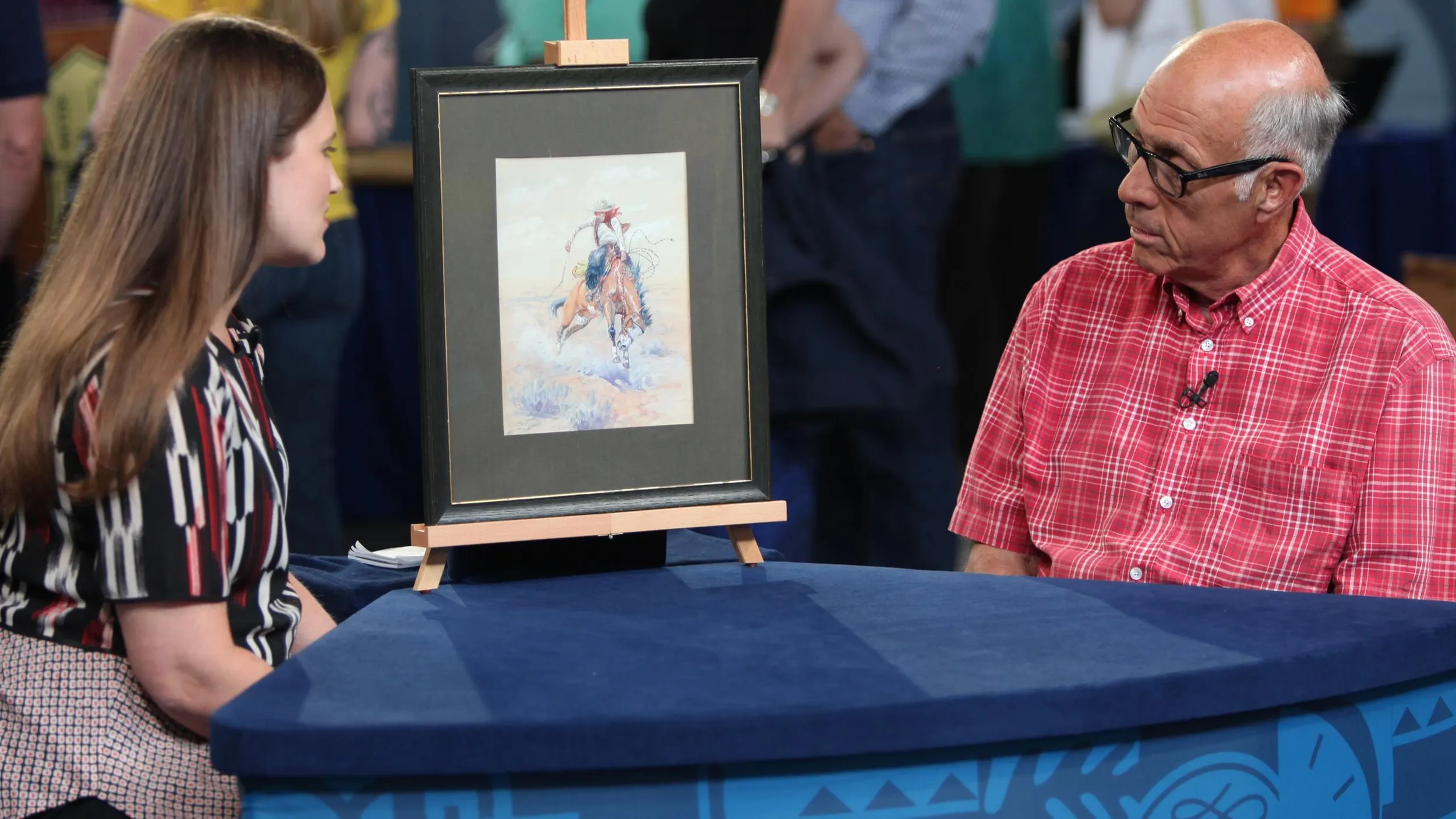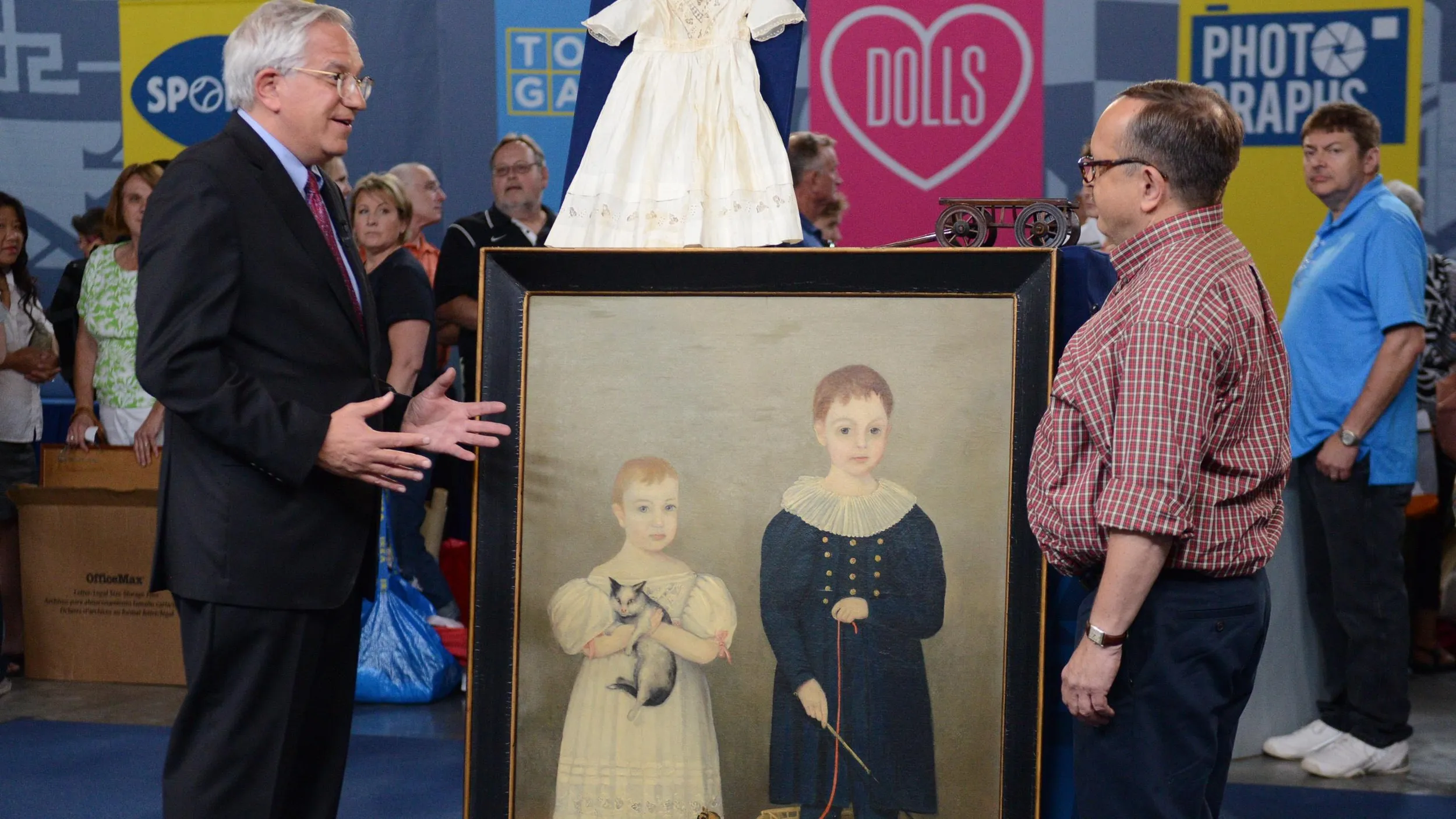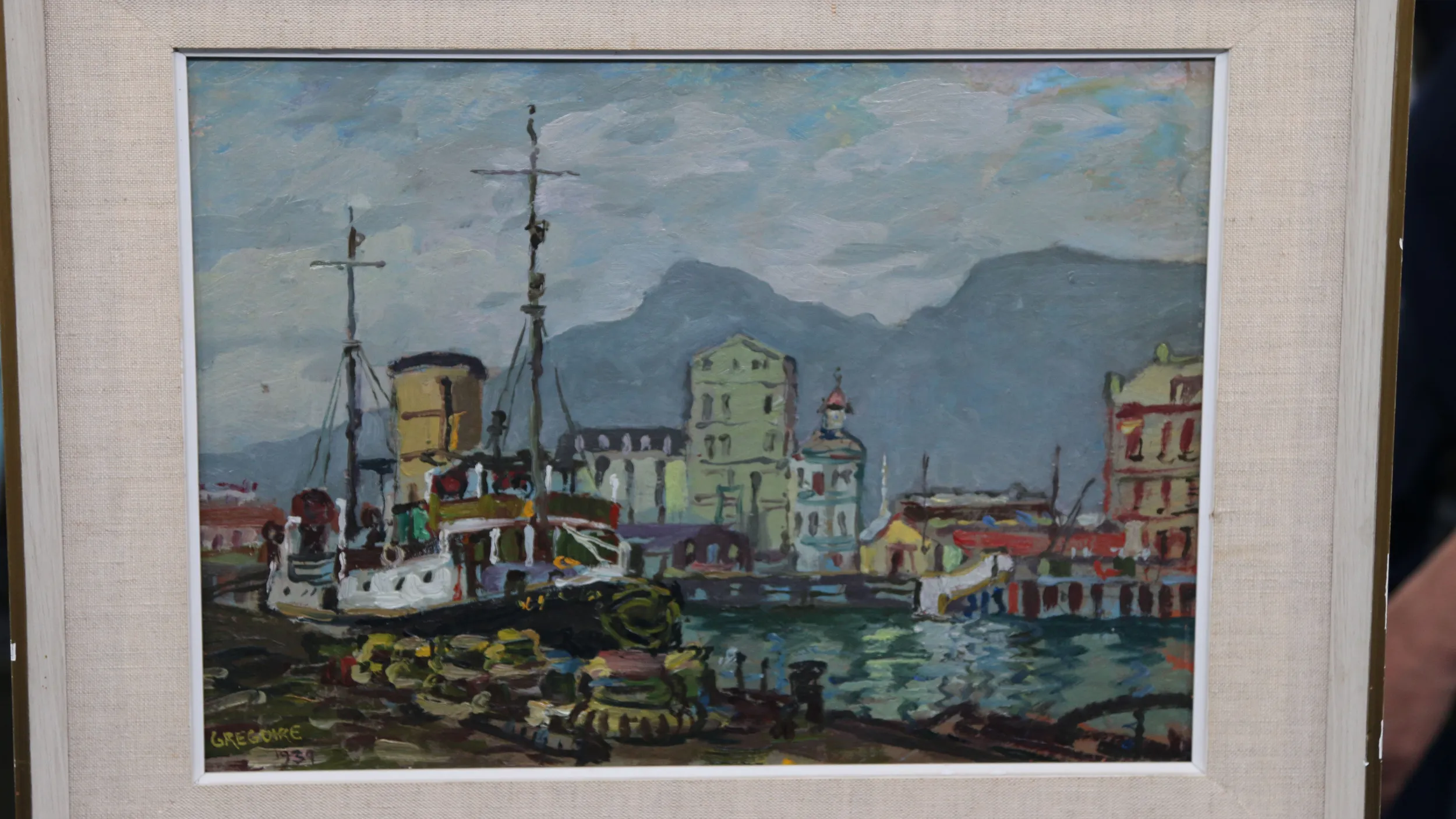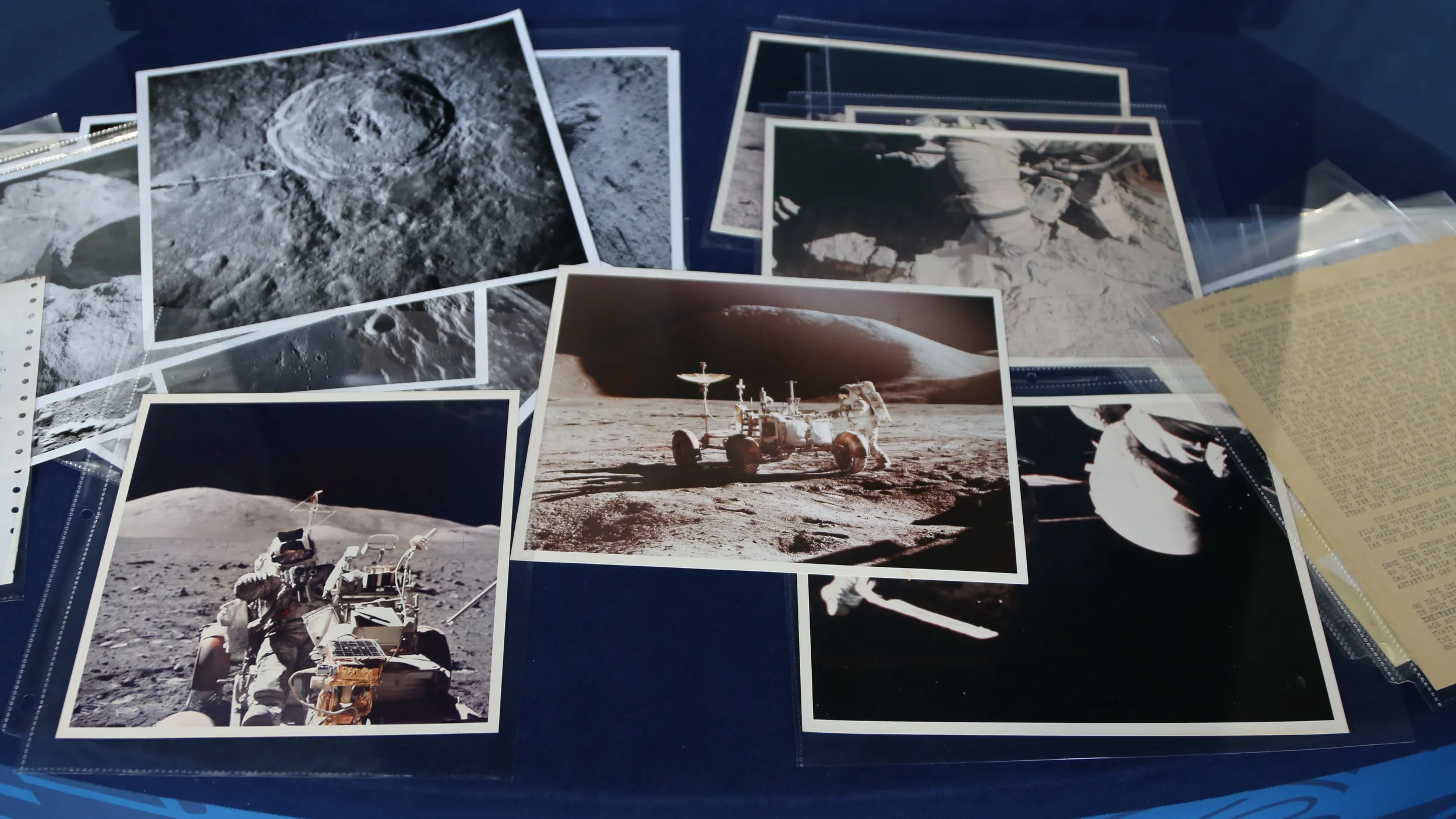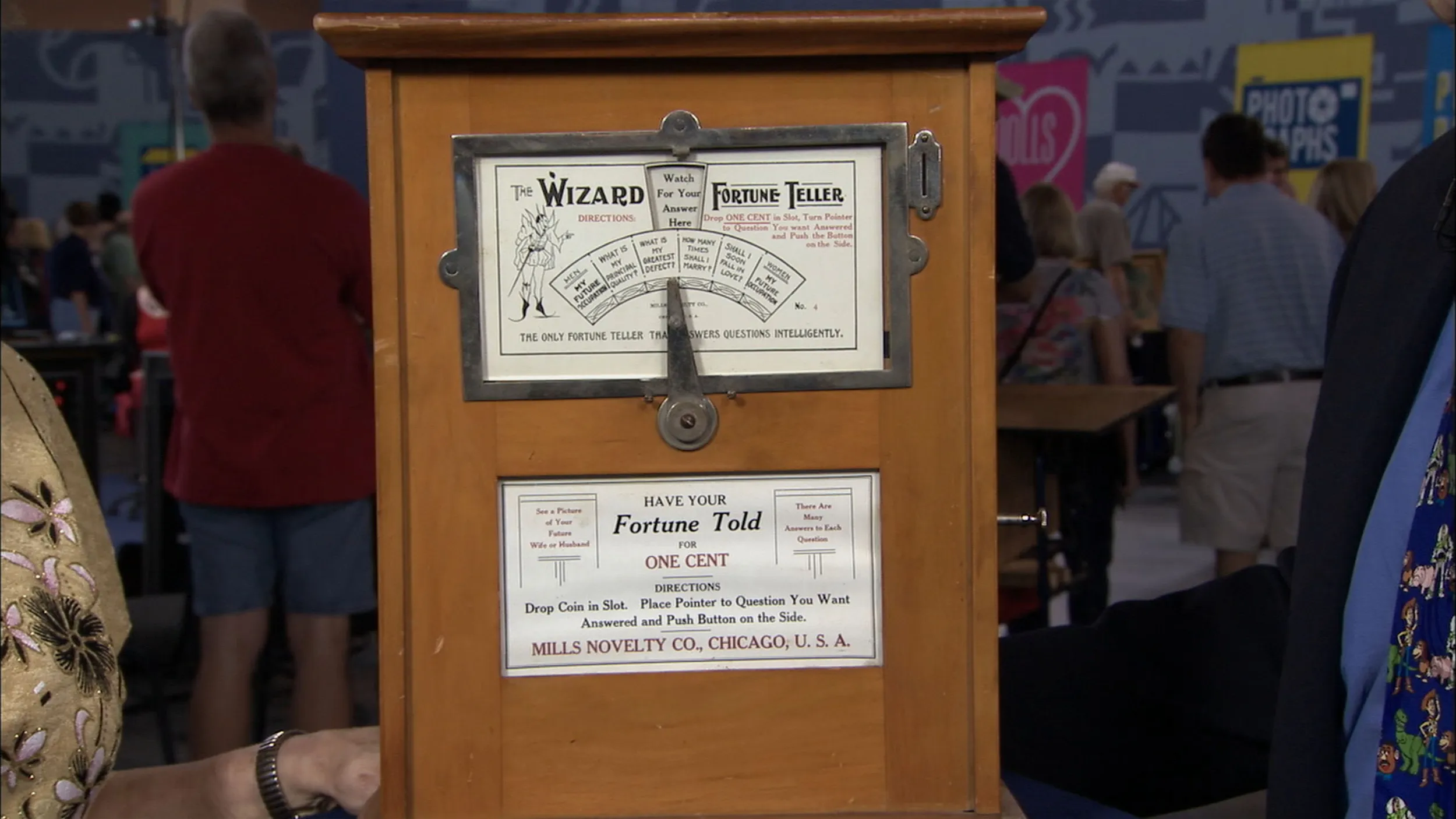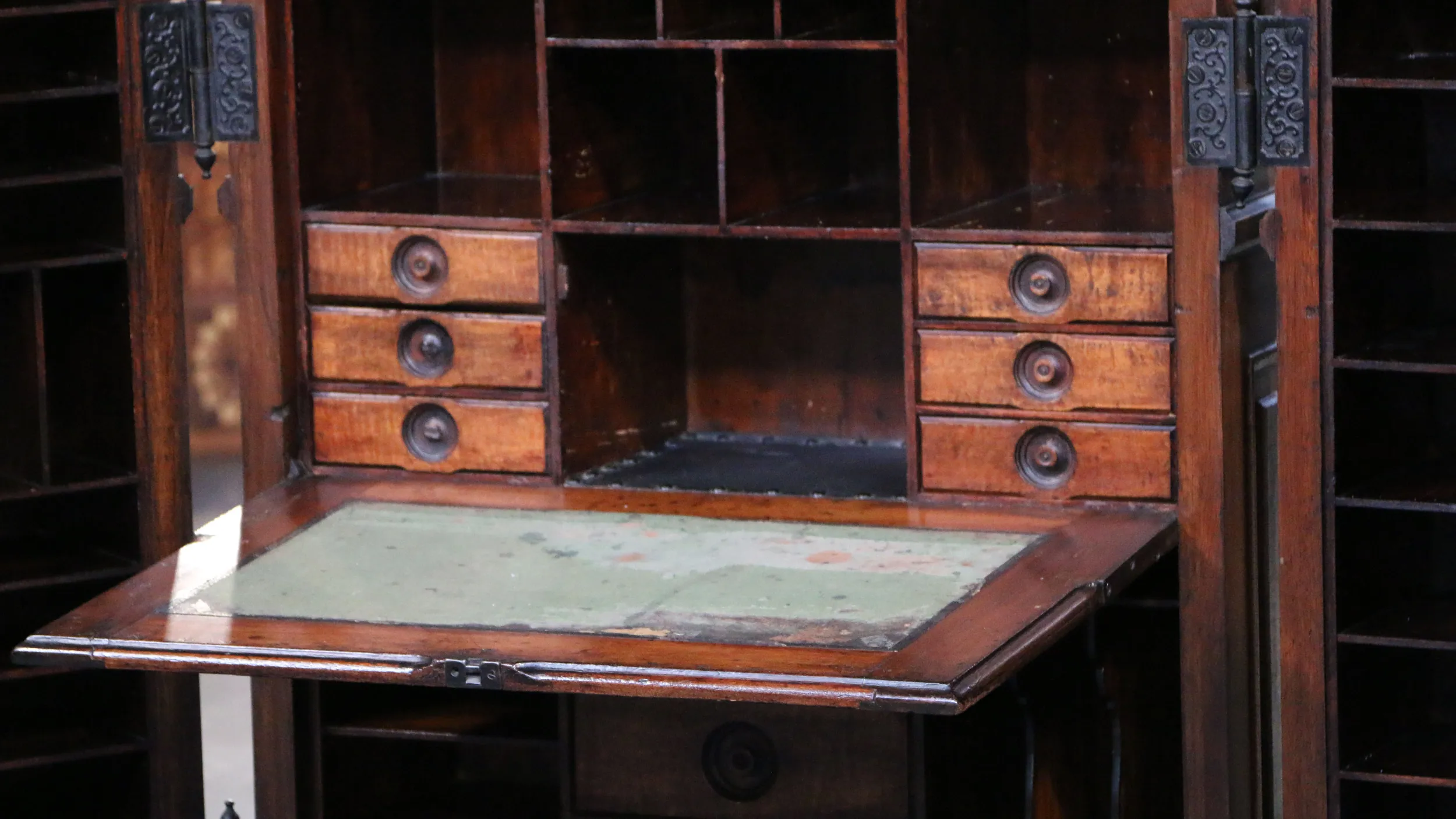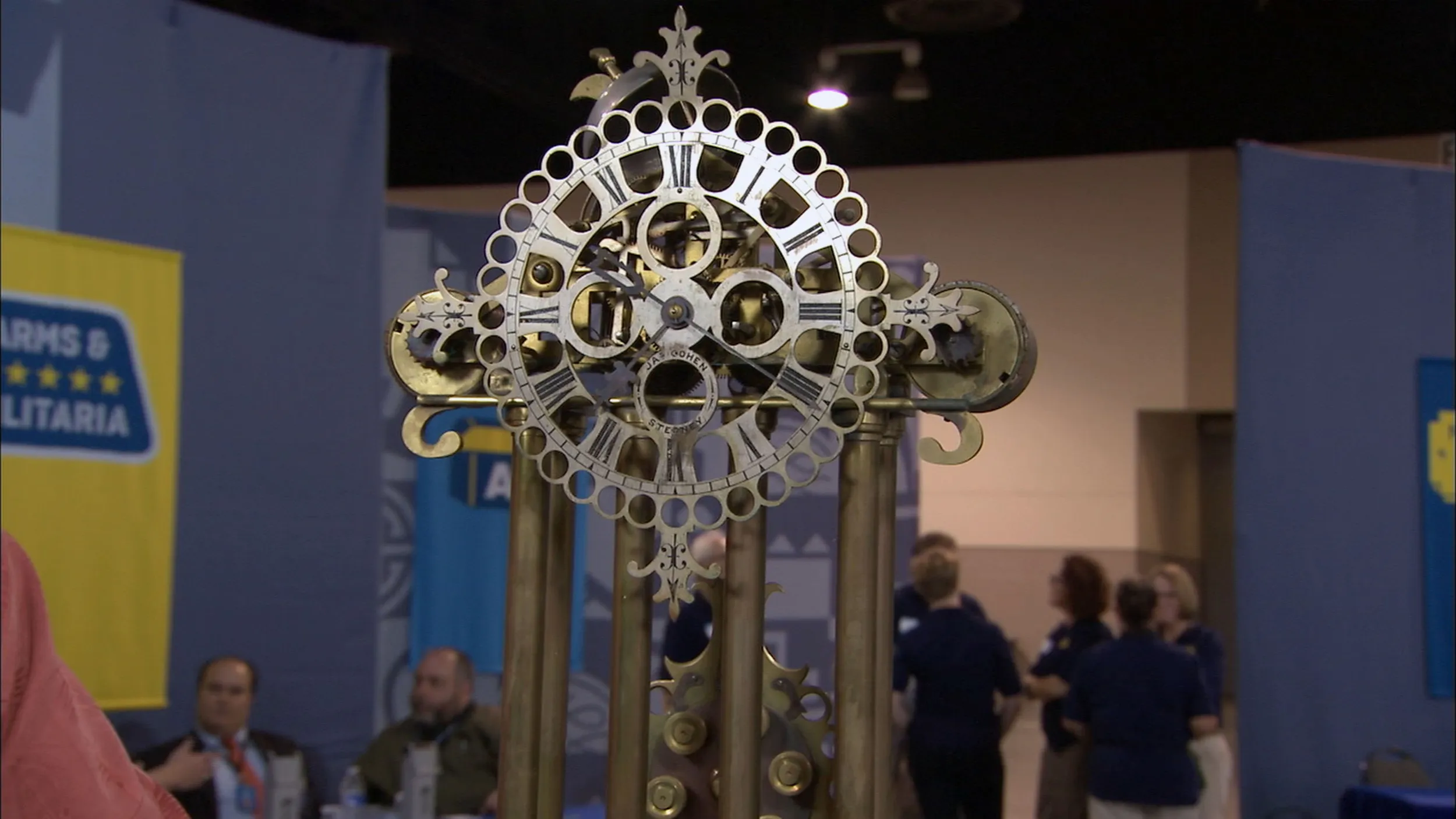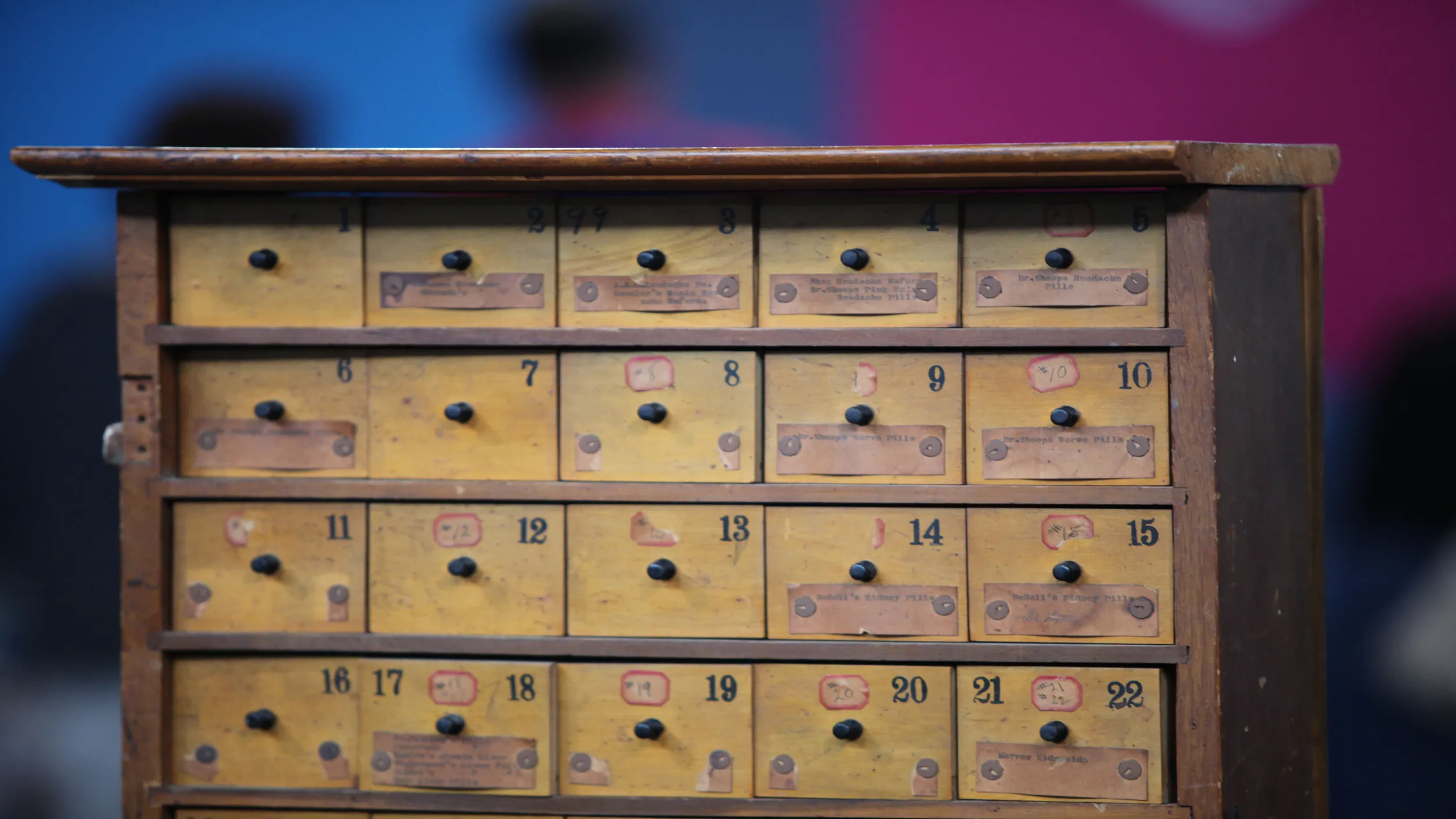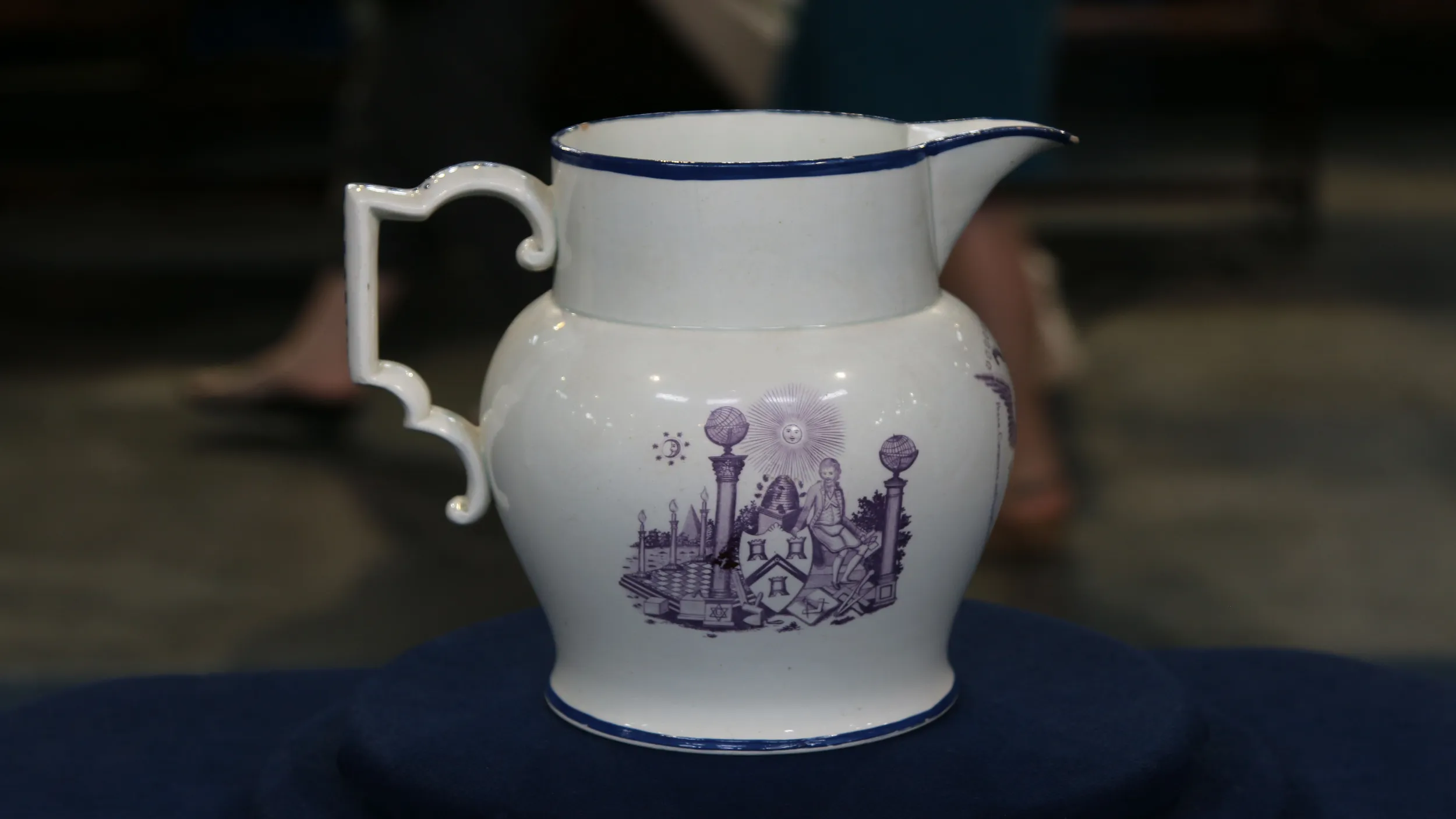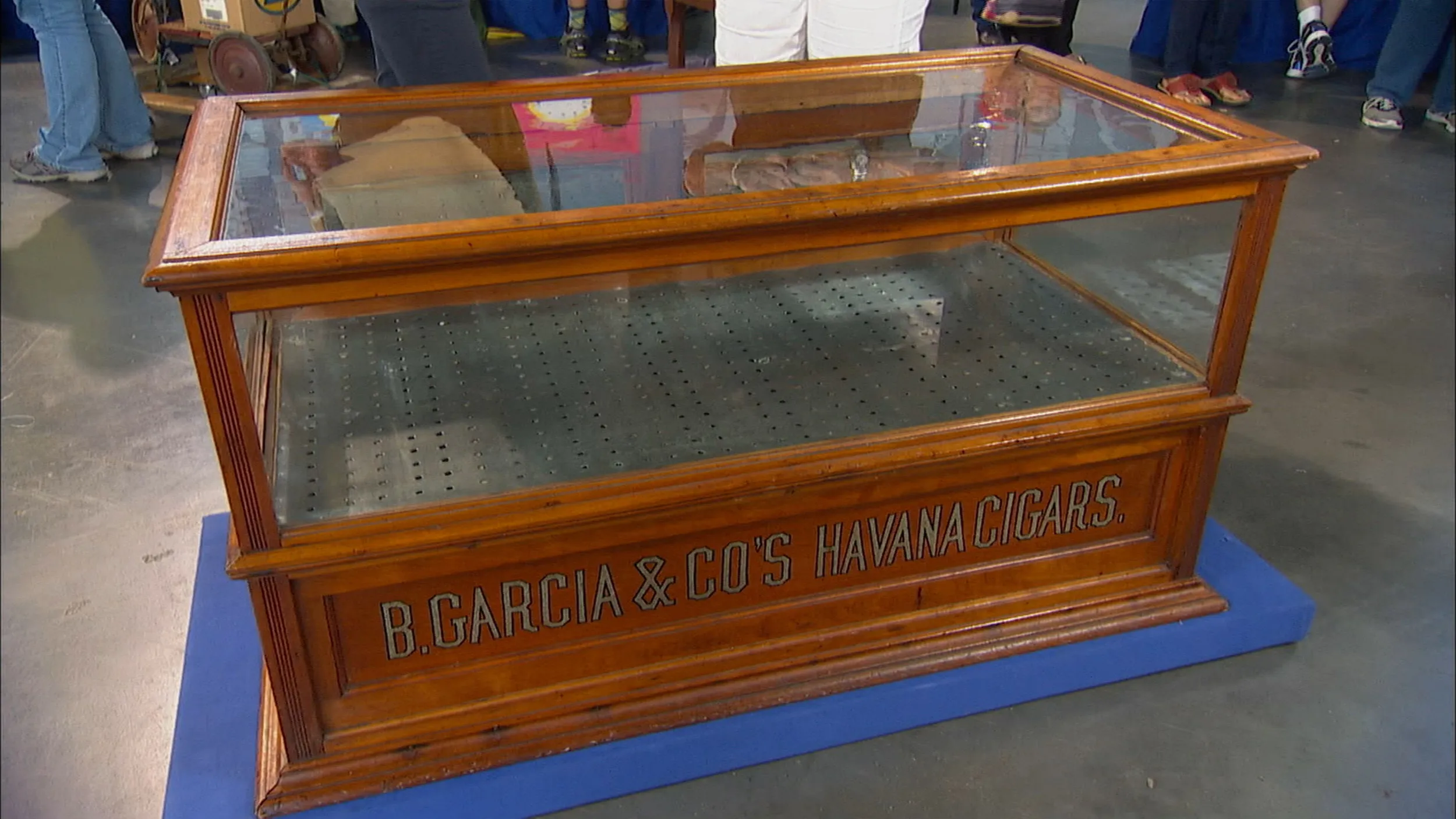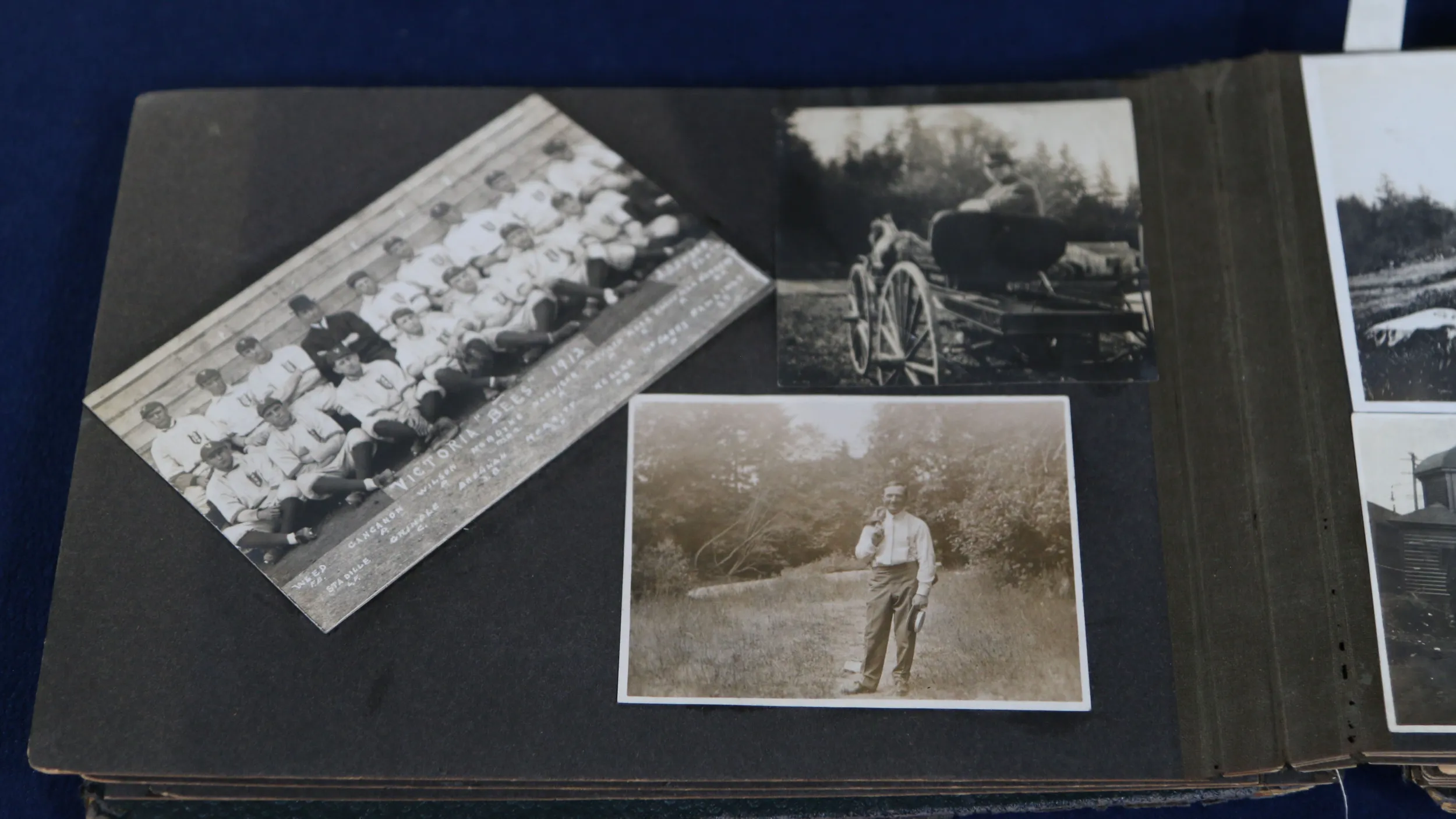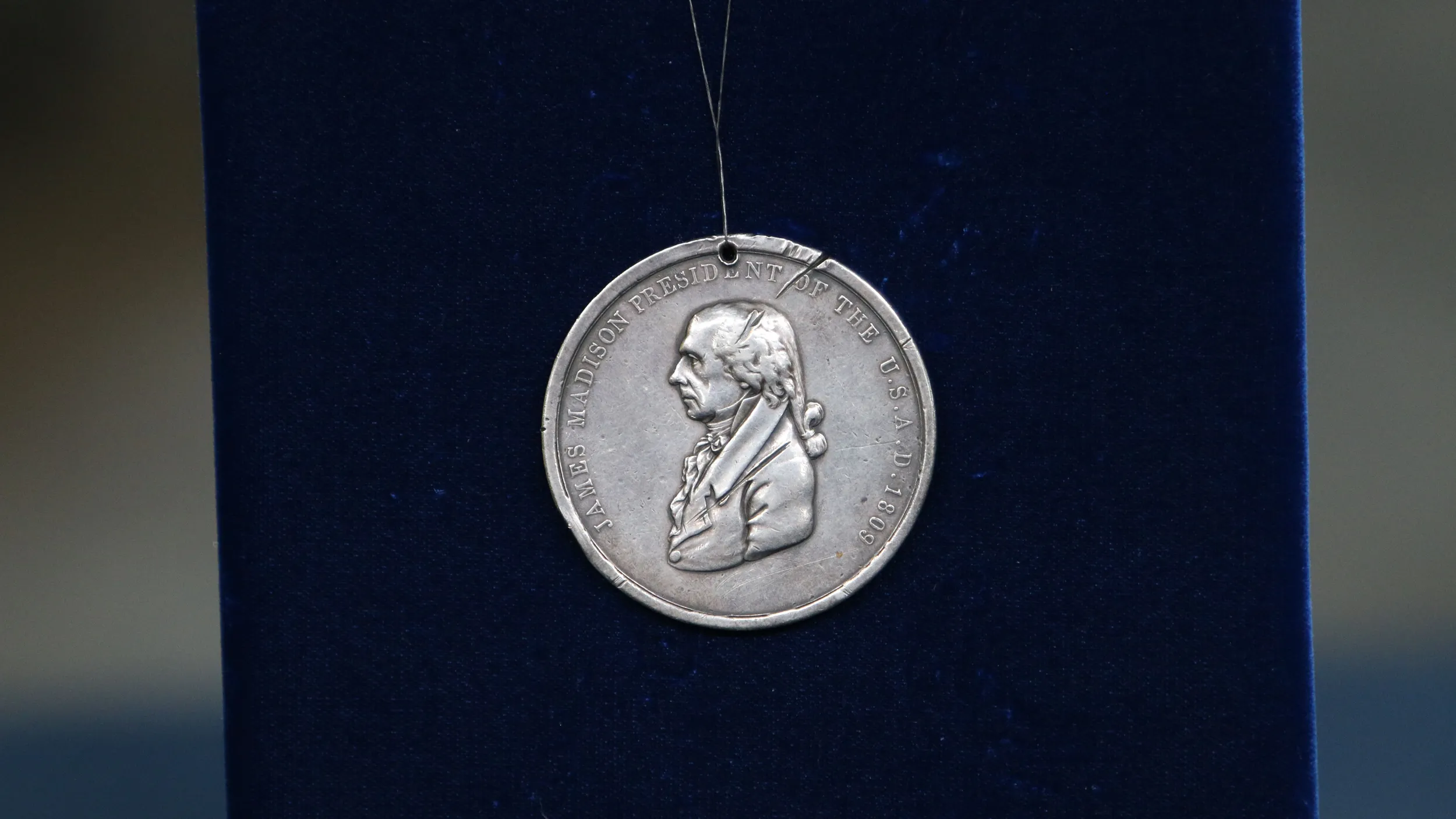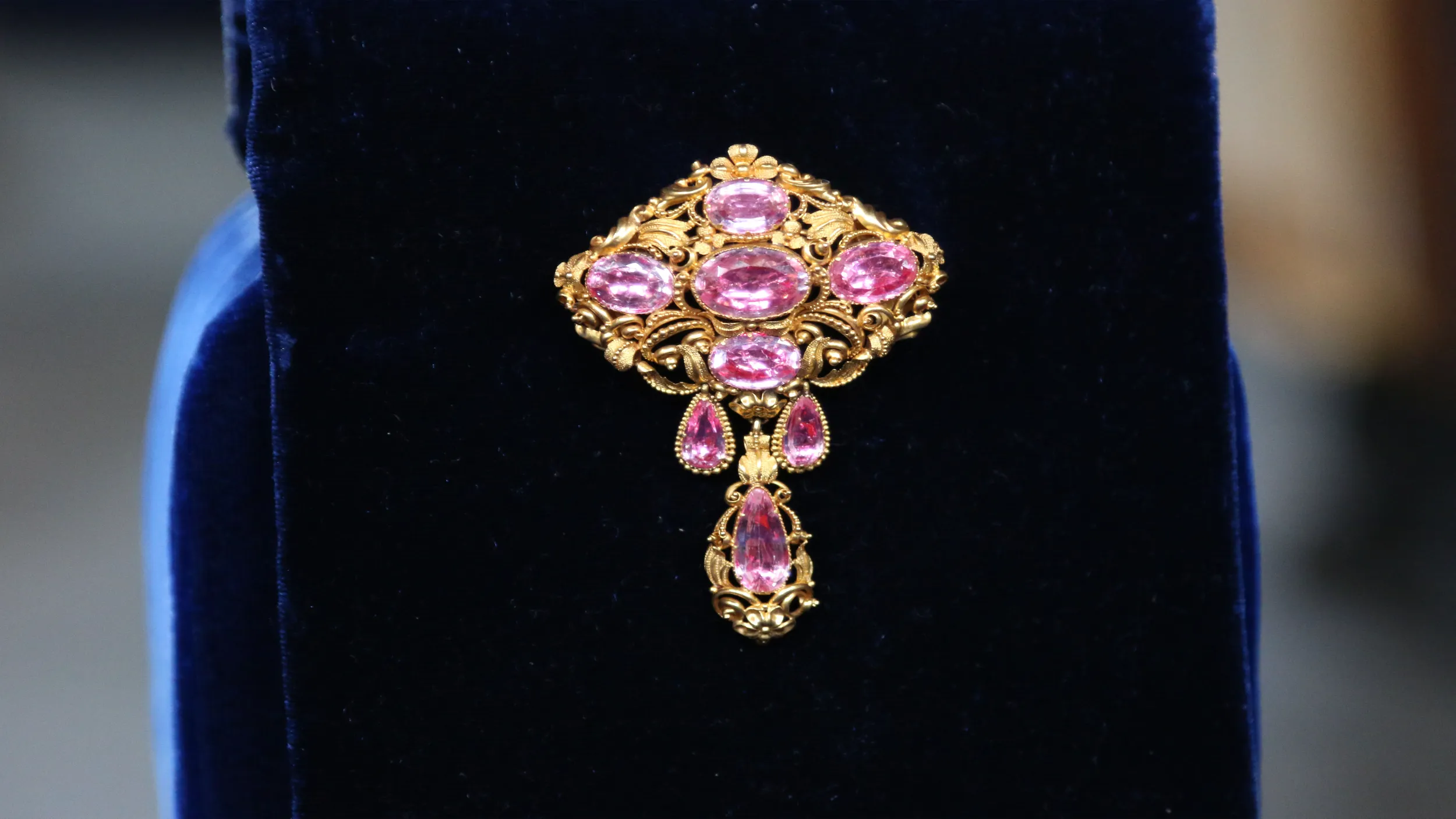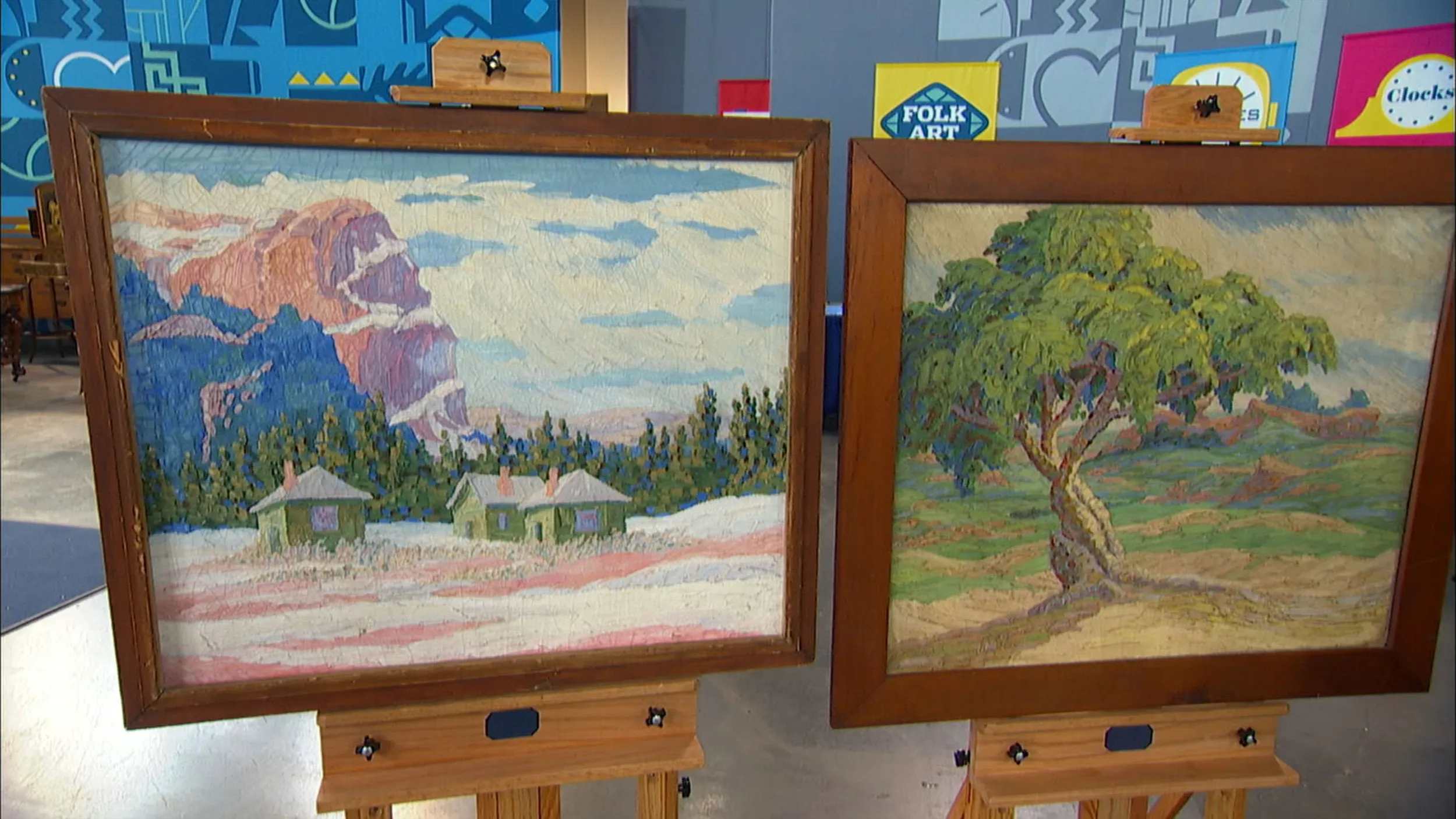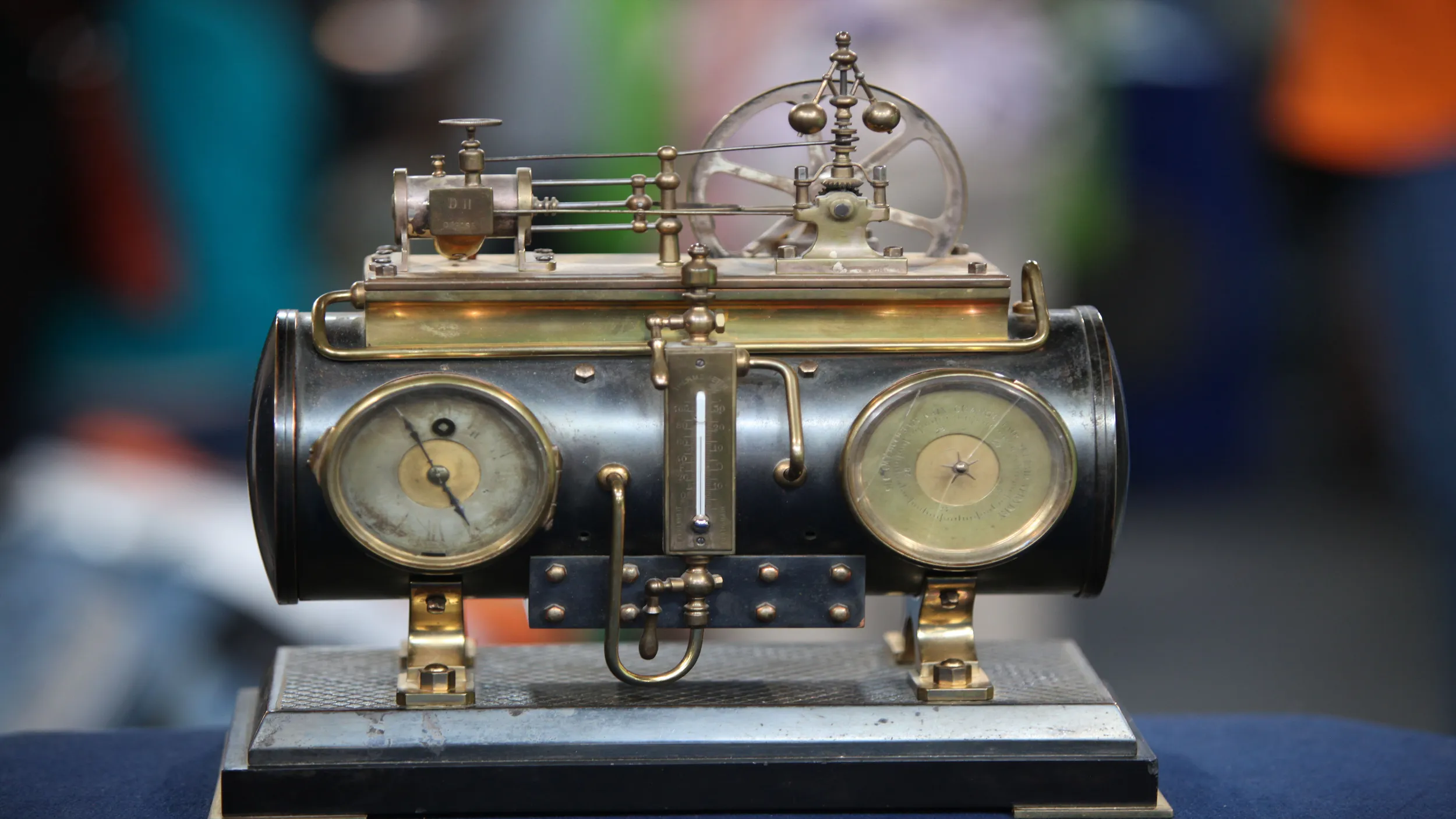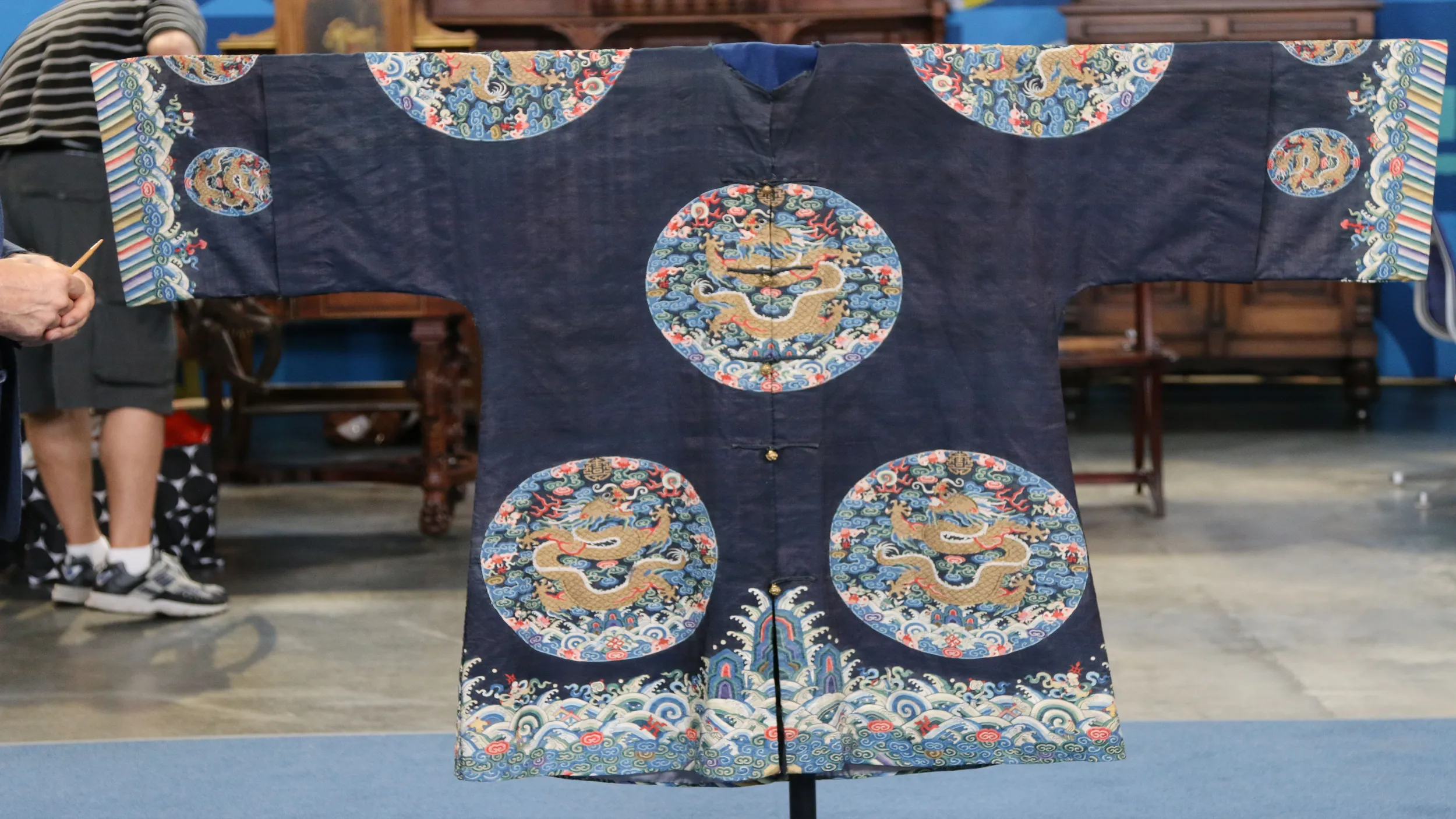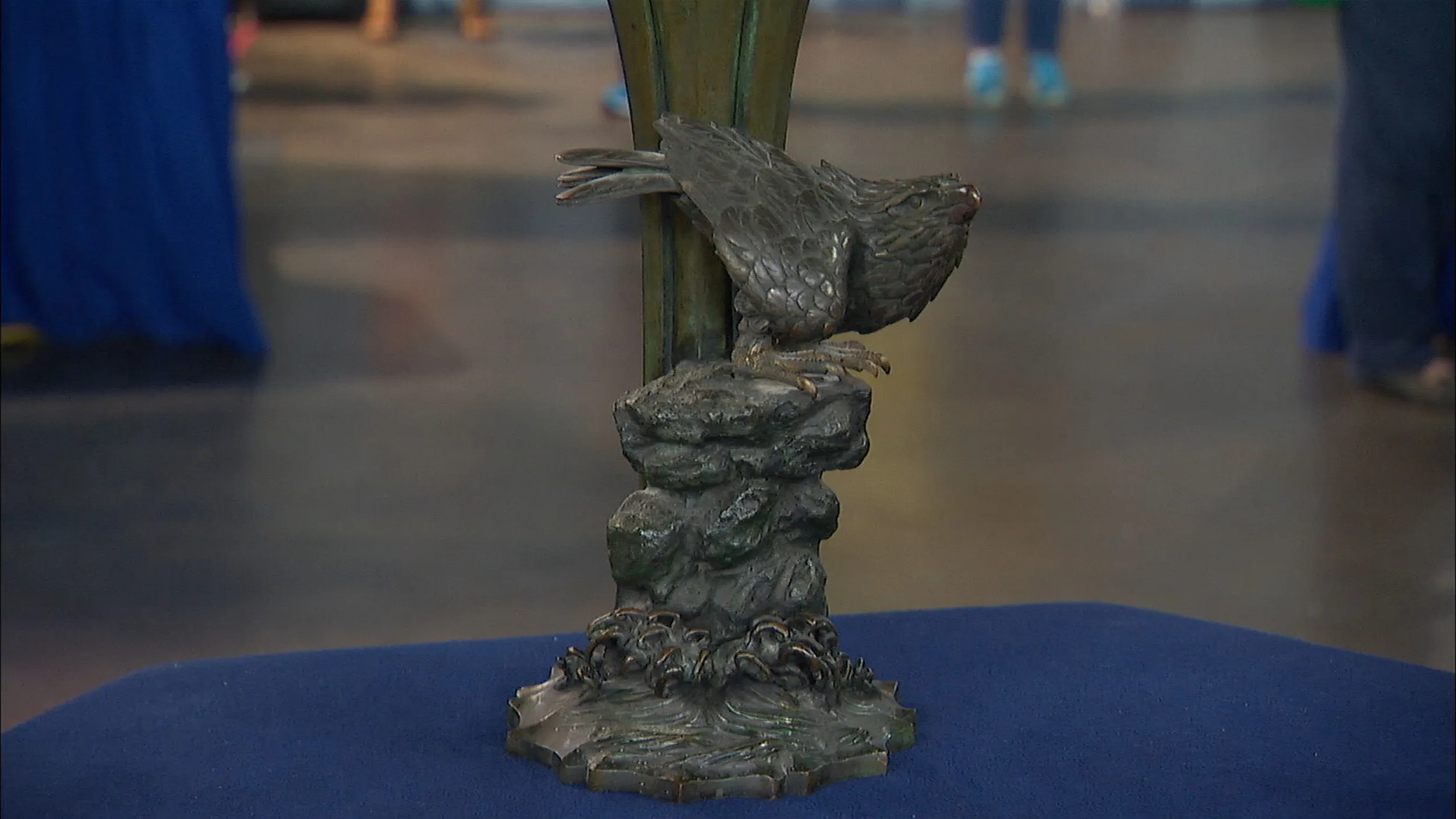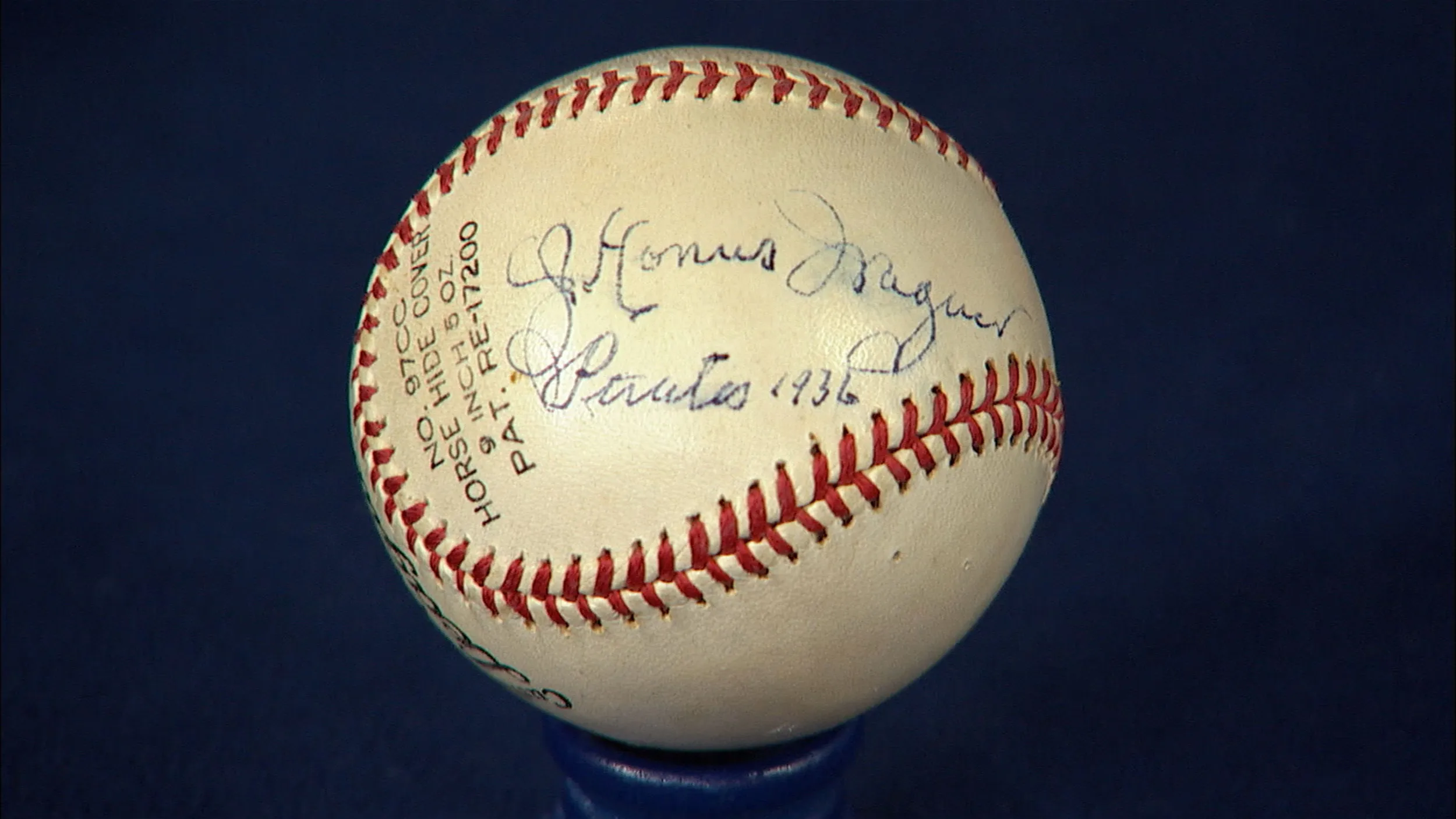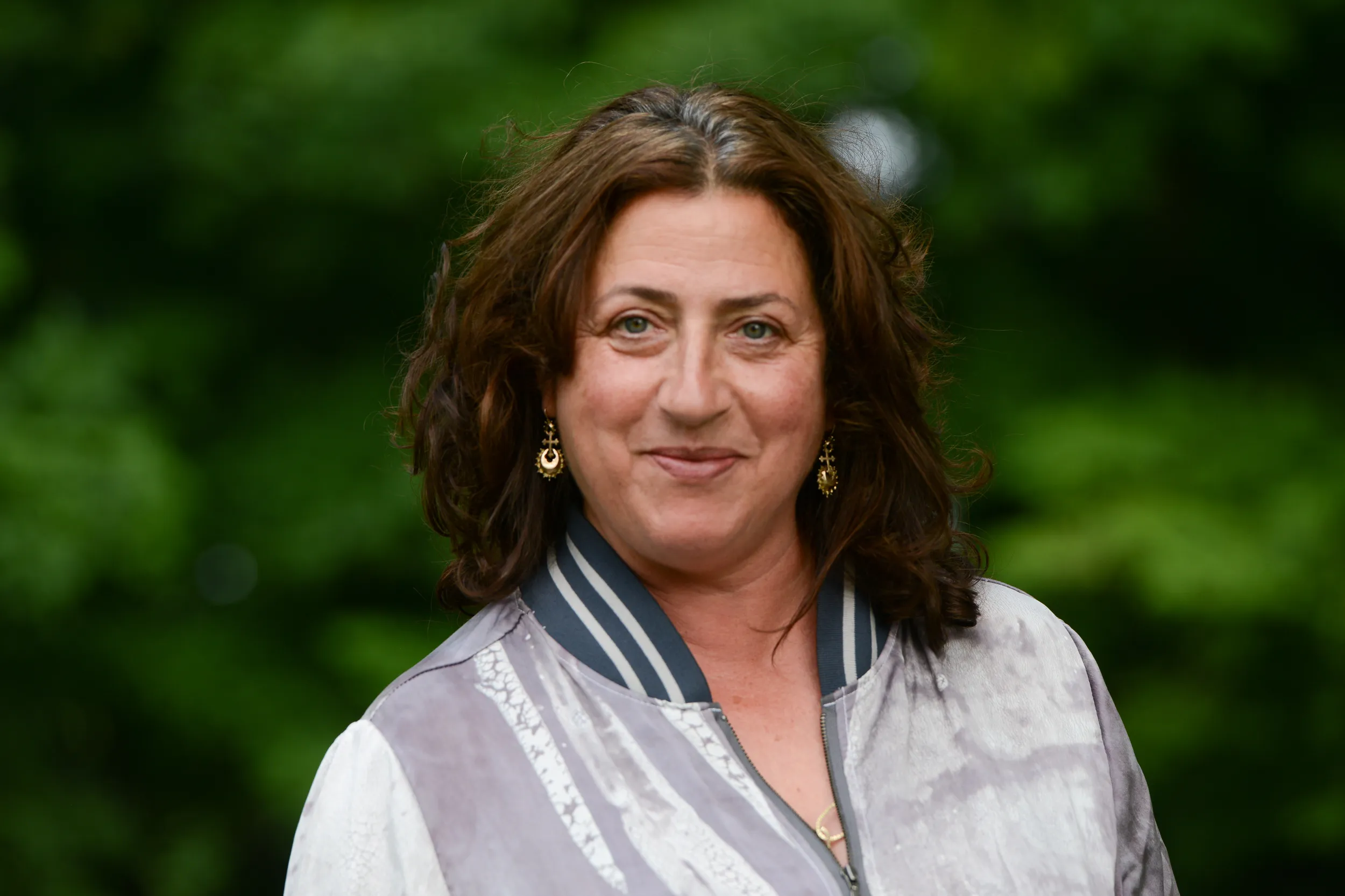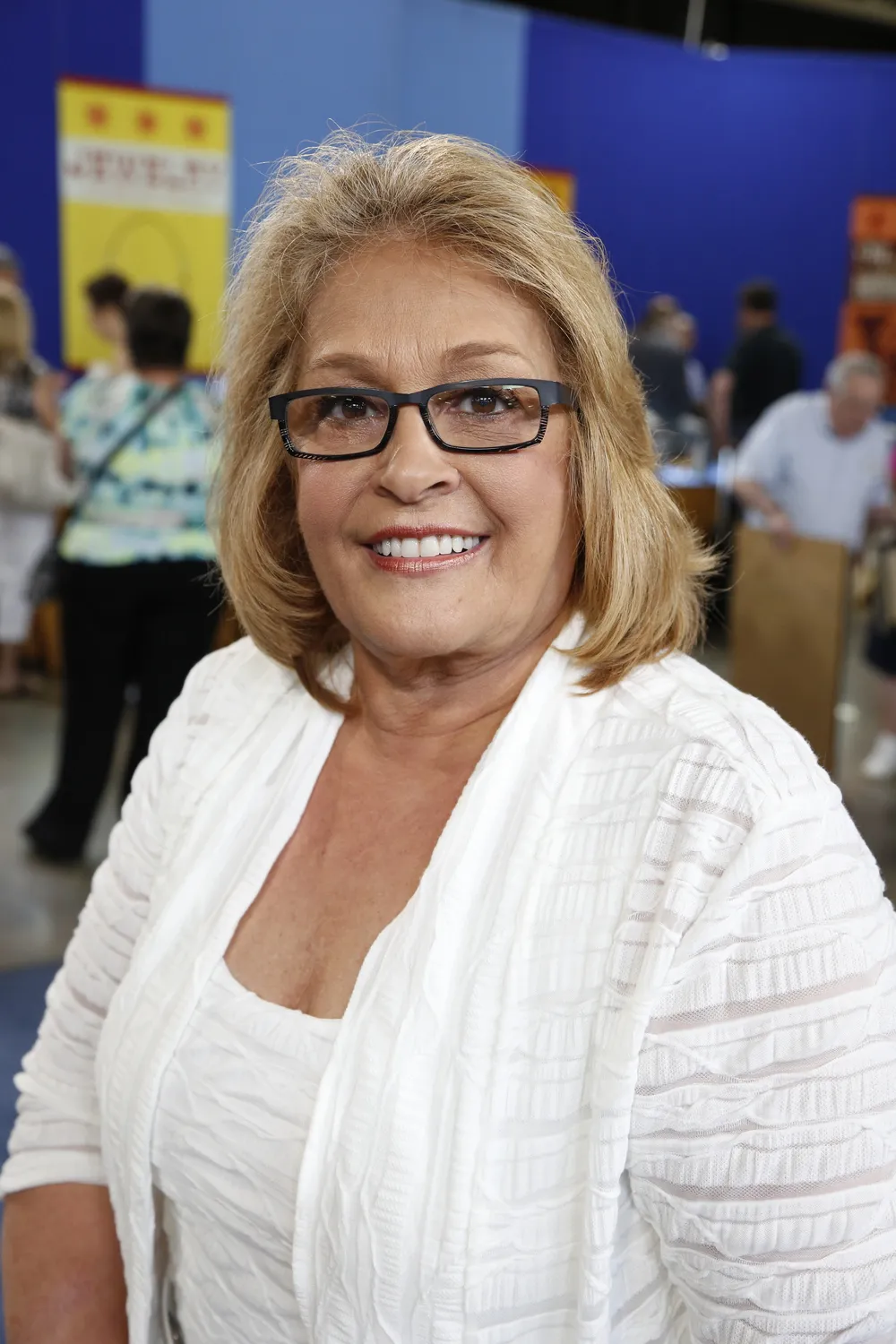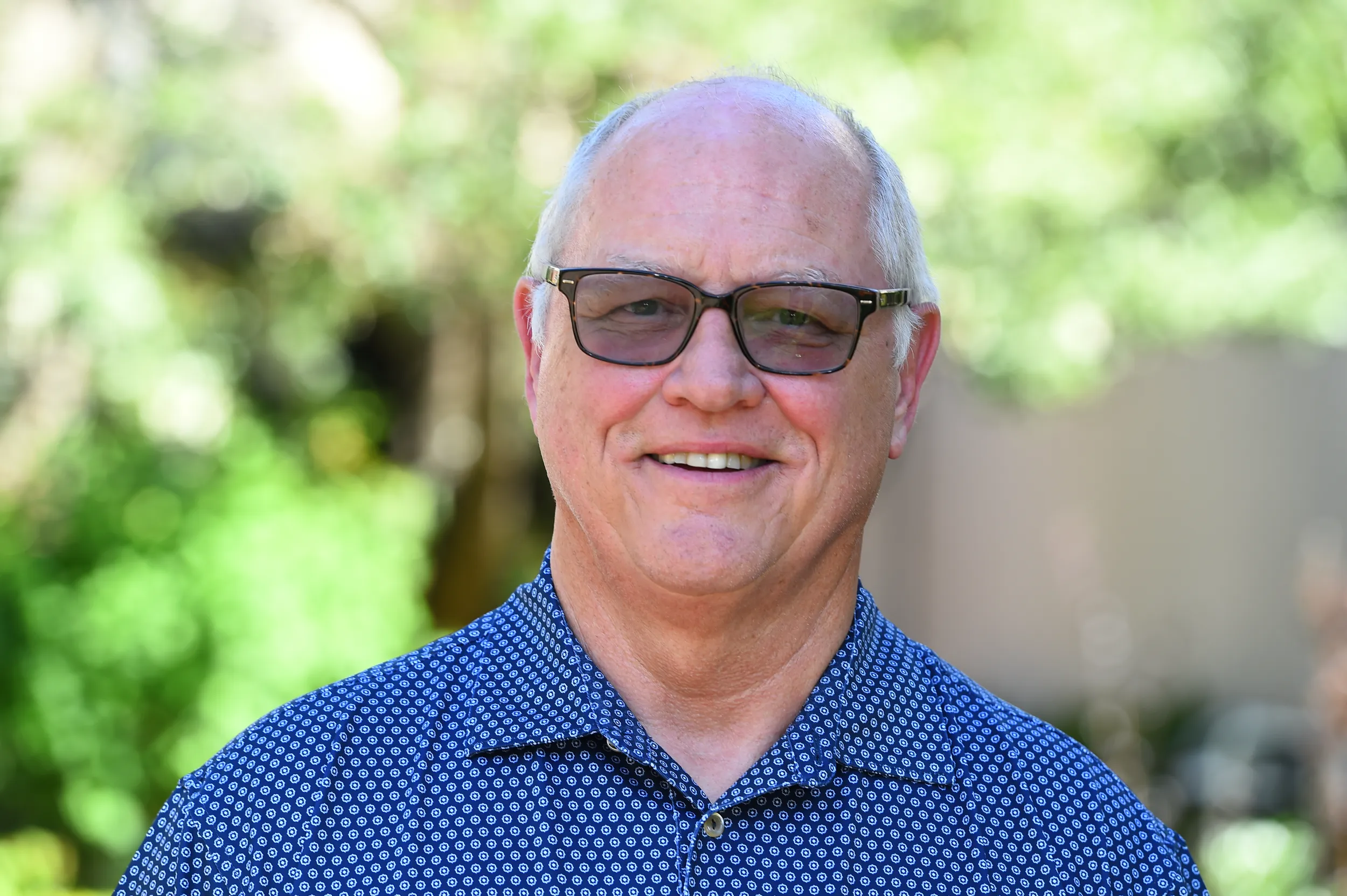HOST: Antiques Roadshow has the inside scoop on art, antiques, and collectibles from Omaha right now.
GUEST: My knees are shaking. I can hardly stand.
GUEST: You're kidding.
GUEST: No!
GUEST: Well, that's good to know.
GUEST: Marvelous. I am delighted.
HOST: Antiques Roadshow's stop in Omaha included a visit to the Durham Western Heritage Museum. The museum's home is Union Station, a 1931 Art Deco beauty that saw millions of rail travelers in its day. Over 10,000 treasures have made it to Roadshow today, and many, like this painting, are originally from places far from Nebraska. Check it out.
GUEST: I'm American-born, but my parents were South African diplomats. And while I was growing up in South Africa, we would go to the docks. My father loved the docks. And that is Devil's Peak and Table Mountain. And he would take us on, like, a Saturday or a Sunday, and I was sure it was to get out of my mother and grandmother's hair. It's very sort of sentimental. I really love this painting. And so when my father and my mother of course had both passed away in '92, there were some paintings in the house, and I got to choose this one. I don't know, I just love that scene. It reminded me of my dad.
APPRAISER: Well, it's a lovely example of the work of the South African impressionist painter Gregoire Boonzaier. The painting is oil on board.
GUEST: Okay.
APPRAISER: And he was really a very, very well trained and important artist. He was born in 1909 and died...
GUEST: Oh, really?
APPRAISER: Oh yes, and died in 2005.
GUEST: So it is recent.
APPRAISER: Yes, yes.
GUEST: Oh, my word.
APPRAISER: He was in his 90s when he died. But what really fascinated me about him was his political side.
GUEST: Oh, really? Okay.
APPRAISER: Yes, yes. He was a very early member of the South African Communist Party.
GUEST: You're kidding!
APPRAISER: And was also a founding member of a group called The New Group of artists.
GUEST: Okay.
APPRAISER: And what was interesting about them is that they were very socially conscious. And he founded this group in 1937.
GUEST: Okay.
APPRAISER: And we see the painting is signed lower left and dated 1939, so it - it was around this time when this New Group evolved. And what was interesting about them was that they were very socially conscious, were very anti-apartheid…
GUEST: Yes, okay.
APPRAISER: …And believed that paintings should be in every atmosphere. Not just the wealthy should have paintings, but everyone should have paintings. So it was not only an art movement, but it was a political movement as well, so much to the point that in 1999, he received an award from Nelson Mandela.
GUEST: Oh, how marvelous! Okay!
APPRAISER: Yes, yes. So this is a lovely scene of Cape Town, as you described the location with the harbor. In terms of its value, he's sold paintings for over $90,000, over $100,000.
GUEST: You're kidding!
APPRAISER: No.
GUEST: I had no... If you had told me he'd sold paintings for $20,000, I would have said okay.
APPRAISER: No, no, they're very, very popular, very important artist. And given the size and subject matter and quality of the piece, while small and early, I would put it at between $10,000 to $15,000 at auction.
GUEST: Marvelous. I am delighted. Oh, this is great. But I am so interested in that history. I just had no idea.
APPRAISER: Oh, it's fascinating, isn't it?
GUEST: I am delighted, and thanks.
APPRAISER: Oh, good, good.
GUEST: Oh, this is good.
GUEST: These are pictures that were given to my father by a fellow who lived behind him, and so I inherited them. The pictures are an amazing assortment from the Apollo program. It's very neat. It's our, our history in space.
APPRAISER: I agree that these are really important photographs, and they relate to the Apollo 14, which was in 1971, and Apollo 17, which was in 1972.
GUEST: Right.
APPRAISER: The astronauts associated with the Apollo 17 mission, the photographers who actually made these images were Gene Cernan and Jack Schmitt. And so what we see is a panorama of types of images, as well as material that was originally produced to document and record the space program. But what's happened in the ensuing decades is this material has been elevated to status as fine art photography.
GUEST: Okay.
APPRAISER: And so when we look at the images, we see different types of pictures. This is from the Apollo 14 mission, and this is apparently the Fra Mauro landing site. These are images in the center that show different details of the Apollo 17 mission. Up here, we see some stunning photographs that tell us something about heroism, they tell us something about space, patriotism, and they have these extraordinary details of the quality of light on the moon. Now, the other thing that I like about these is that in this central image here, we see that the caption is hand-written…
GUEST: Right.
APPRAISER: …On the back of the print. So when NASA generated photographs of the different lunar missions, there was always the NASA mimeograph logo and a full caption. Here, we have hand-written captions, which tells me these photographs are more special. We're looking at different tiers of value.
GUEST: Mm-hmm.
APPRAISER: The images of the landing would be perhaps in the $100 price range.
GUEST: Really?
APPRAISER: The images that show details of the Apollo 17 mission, in the $150 to $200 price range. And these color images that show a vista—with… in that image, you can see Earth in the background.
GUEST: Right, right, right.
APPRAISER: These would be in the $500 range.
GUEST: Wow.
APPRAISER: So if we look at the entire archive, an auction estimate would be $5,000 to $7,500.
GUEST: Wow. Had no idea. That's amazing, that's amazing. I'm stunned.
GUEST: Yeah, I've never seen a horse who had an obituary in the paper.
GUEST: Is it dirty, or is that the color?
GUEST: I think that's the color.
APPRAISER: The paper is decaying. But it's a pretty image.
GUEST: Uh, we got this at...
GUEST: An estate sale.
APPRAISER: How much you pay?
GUEST: Twenty dollars.
GUEST: Well, it was acquired through a friend when I was helping her clean out a place, and we had to clean out this place, and she says, "Take whatever you want for helping me." And so I took this, and I brought it home about 50 years ago.
APPRAISER: Uh-huh.
GUEST: And my husband was so mad at me because I brought this junk home.
APPRAISER: Well. I'm not mad at you, I'm glad you brought it here.
GUEST: Yes.
APPRAISER: It's really a really terrific penny machine. It's called the Wizard Fortune Teller. It was made by the Mills Novelty Company, who were one of the great makers of slot machines and all kinds of gambling paraphernalia. They made several versions of this. The later ones were made in metal. This one dates from around 1904.
GUEST: Okay.
APPRAISER: And it's in extraordinary condition. So let's see how it works before we... lets… we put a penny in, and then we - we're going to go, " What is my greatest defect?" "Your greatest defect is that you are alive."
GUEST: (laughs)
APPRAISER: Well. That's rather insulting.
GUEST: It is.
APPRAISER: Well, anyway, I don't want to insult you, but this is a great machine.
GUEST: Is it?
APPRAISER: Ah… the only other one I've seen recently sell at auction was for $1,400.
GUEST: $1,400.
APPRAISER: And it was not in as good a condition as this one. Somebody had written over this and said, "Five cents."
GUEST: Oh.
APPRAISER: This one is perfect. I think on today's market at auction, easily $2,000.
GUEST: Wonderful. God, the junk I brought home.
APPRAISER: I think you did the right thing bringing it home.
GUEST: Oh, thank you so much. I'm overwhelmed, I really am.
APPRAISER: Oh, that's great.
GUEST: That's super. I can't wait to tell him that. (laughs)
GUEST: Well, this is a Wooton desk that I think was made sometime in the late 1880s. It came into our family sometime in the 1930s. And I think at one point, it was refinished somewhere in Minneapolis, and then it's been in my family ever since.
APPRAISER: Okay. Do you know who the original owner is and what he did?
GUEST: I don't know from the 1880s to about 1930. We couldn't track it down, we tried.
APPRAISER: Okay, well, this is a very recognizable model. It's a Wooton model desk. It was patented by William Wooton and manufactured in Indianapolis. They claimed fame in the 1876 Centennial exhibition, and it was a desk that was for titans of industry: bankers and industrialists and robber barons of the era. There's something about this desk, though, that stands out to me. Do you know what that is?
GUEST: Well, there's a secret compartment.
APPRAISER: Okay, and I want you to show that to us, but--
GUEST: I will.
APPRAISER: But more specifically, they made four different versions of this desk. They made an ordinary version, a standard grade, an extra grade, and a superior grade. This is the ordinary version. So the least elaborate example of the four.
GUEST: Right. And I think there used to be some finials up here, too, didn't there?
APPRAISER: There was. But they also made three sizes, and what makes this special is its diminutive size. This measures 36 inches wide, and it was referred to as a lady's Wooton. So when you think of industry and you think of captains of industry, how many times do you think of the ladies, females in that role in the 19th century? And that's what makes things rare. So, sometimes rare is good for value, and sometimes it's not so good for value. In this case, it's good for value.
GUEST: Good.
APPRAISER: This is the letter drawer, and here we have the patented mark by… by Wooton that identifies it as a Wooton. And when we open it up, we see how it functions. We can notice all of these compartments. There was a place for everything, and everything had its place. These originally would have had small… like, cardboard drawers that would pull in and out, and that would be filing checks and paperwork. And at this time in America, we're – we’re starting a paper trail. Prior to that, we would just work out of one ledger. Now there's typewriters and so much to store…
GUEST: Right.
APPRAISER: …That we want to make it neat and tidy for everybody, and this was the way that Wooten designed this, and that's what gained him fame. Now, you mentioned there was a secret door. Could you show our guests?
GUEST: Right here. So when the doors are closed, it's locked down.
APPRAISER: Yeah. Well, he was an innovative designer, William S. Wooton.
GUEST: Yeah, it's pretty neat.
APPRAISER: The Wooton desk was primarily manufactured in walnut, and if we see here, this is a burl walnut panel. 15 years ago, they were commanding more money and were more collectors for them than there are today. At auction, we put a conservative estimate of $4,000 to $6,000. But if we were going to insure it,
it is not an easy thing to replace, this size. I've only been able to locate about four in this size, and they can be priced and have sold for a lot more than the $4,000 to $6,000.
GUEST: Okay.
APPRAISER: So this would be something that we would try to generate interest with a $4,000 to $6,000 estimate, but really it would be the market that would tell us what it's ultimately worth because one hasn't sold in a long time.
GUEST: Okay, appreciate it.
GUEST: It was sitting on a workbench in a garage at a garage sale amongst tools and junk. I knew it was going to be mine regardless of the price.
APPRAISER: Did you know what it was?
GUEST: I knew it was Native American. I asked the gentleman how much it was, and I said, "I'll take it."
APPRAISER: How much was it?
GUEST: $75. And the best $75 I have ever spent. I think it's a war club. I think it's a ceremonial piece, maybe? The wear on it isn't such that it would have been used in battle, I don't think. The surface is… is phenomenal. I found it in Overland Park, Kansas, so maybe Prairie Indian?
APPRAISER: It's a war club, and it's from the Great Lakes area. It's hard to say exactly what tribe it is, whether it's Ojibwe or whether it's from the other side of the Great Lakes. It would take some study and some comparison, and you still might not know exactly what it is. It appears to be made from ash, but I think the key word was "ceremonial" with this. I think it dates to around 1850. The scale of it, the weight of it, when you see the older ones, they're generally smaller. I have seen larger ones in museums that date back to the 1600s, but they generally are a smaller scale, and they're heavier, and they're a denser wood. And they were made to crack somebody's skull. As things moved on and times changed, there was less of that, but they were still a tremendous symbol of authority and a symbol of a warrior. It's got some great symbolism on it, and it does have a little damage. If you look over here, this was probably an otter, and his head's missing. It's been broken off right here on the end, but it's been broken off a long, long time. I don't mean ten or 15 years before you got it, I mean it's been broken off probably since the 1800s, so a long time ago. It has tremendous color, it has red ochre rubbed all over this ball, and it has traces of red down the back, and then it has a black color on the backside. If I can take it off of here, you can see the black, it's all rubbed under this side. And there's this star...
GUEST: Wow, yes.
APPRAISER: ...Done with pinheads in the front. Which is just a great detail, really beautiful. And there's red all down here also. And the shape is really elegant, it has a fabulous twist to this. Really clean, beautiful object. What do you think it's worth?
GUEST: I'd… guesstimate maybe $1,000.
APPRAISER: Well, we all looked at it, and we looked at a number of others that have sold in the past five to ten years, and we went through a lot that will never be sold because they're in institutional collections. If this came up for auction, I would easily expect it to bring $15,000 to $20,000.
GUEST: What?
APPRAISER: So a fair amount of money. And, you know…
GUEST: Oh my God, you’re kidding.
APPRAISER: …A good buy at the sale.
GUEST: Yeah, my... my knees are shaking.
APPRAISER: Well, it's a – it’s a beautiful thing. Now, it just doesn't get much better, so enjoy it. You have a treasure.
GUEST: My - my knees are shaking. My knees are shaking, I can hardly stand. This is incredible. I'm so glad I stopped at that garage sale.
APPRAISER: Yeah, no kidding.
GUEST: I am thrilled. I am absolutely shaking.
VOICE: Was that yours as a kid?
GUEST: Yes, it's... well, I'm 76, so figure it out.
GUEST: Hi! How are you?
VOLUNTEER: You can take it to one of these individuals.
GUEST: Okay.
VOLUNTEER: They'll take you to the production area.
GUEST: Thank you.
APPRAISER: This is molded black glass to look like a cameo, and it's brass and copper. And so this would date from the 1920s.
GUEST: Is that right?
APPRAISER: Yeah.
GUEST: I love it.
GUEST: Well, it was my father's, and that's where I got it. Pop came home from a Sunday drive back in the mid-1950s and had this clock with him. He'd been to an auction and brought it home, and it was part of his collection. It had a glass dome on it, and when he was cleaning the clock one day, he cleaned the dome first, then took the clock to the kitchen to work on it. My sister walked in, and he had done such a good job of cleaning the dome, she didn't see it, sat down on the chair, and shattered it, so...
APPRAISER: Oops.
GUEST: Yeah, "oops" is right, big oops.
APPRAISER: This is great, what you've brought here, the - the catalogue where he originally purchased the clock from the Victor Gilbert collection, and there is Victor Gilbert with this clock.
GUEST: Mm-hmm.
APPRAISER: It's a great photograph, and clearly it was his prized piece in the collection. So what we have here is a mid-19th century skeleton clock. It was a tremendous amount of work to make a clock like this, and there are standard examples, there are typical skeleton clocks that we frequently see. This is not one of those. It's very unusual, almost like a one-off piece. These columns are very unusual. If we spin it around a little bit, you can see the clock movement in there. For the clock people out there, it's a double fusee movement, time and strike. And this very unusual pendulum with these knurled adjustments, they look like. So a very interesting clock. The bell is… bent on the top, that's something that could be restored pretty easily by a clockmaker. And the maker's name is here on the dial, but there's nothing listed, I couldn't find him…
GUEST: Yeah, I couldn’t either.
APPRAISER: …So maybe he just made one clock? May have been a jeweler. Any idea what this clock might be worth today?
GUEST: Well, Pop bought it in the mid-'50s for $500.
APPRAISER: That was a lot of money.
GUEST: Yeah.
APPRAISER: This is a clock that even in this condition I think would sell at auction in the $4,000 range.
GUEST: Oh, okay. That's great. And if I get it repaired?
APPRAISER: Quite a bit more. I could see this fully restored selling for $7,500, in that range.
GUEST: Okay.
APPRAISER: So well worth restoring.
GUEST: Okay, well that's good to know, thank you.
APPRAISER: Thanks for bringing it in.
GUEST: Pop would be glad to hear that. Thank you very much.
GUEST: My husband's been a collector for a long time, and we've had this in our home for about 40 years. And… we were lucky enough to get tickets to come to the Roadshow, so my daughter and I decided to pick a few things from the collection, and this was one of them.
APPRAISER: Right, and what can you tell me about it?
GUEST: All we know is it's possibly a French Indian war hatchet or axe, 1850s possibly, 1860s. Other than that… came from an estate sale, and we've had it for years.
APPRAISER: An estate sale in Iowa?
GUEST: Uh, yes.
APPRAISER: Okay. I don't believe it's a war hatchet. It's sort of too short for that, okay?
GUEST: Okay.
APPRAISER: But what I do think it is, it's from the 17th century, and it's definitely continental, and probably… Italian.
GUEST: Italian?
APPRAISER: And it's got some wonderful details upon it. Here, you'll see it's got this carved head on the end.
GUEST: Yes.
APPRAISER: Quite typically Italian actually, even Venetian. It's got these chubby cheeks.
GUEST: Yes.
APPRAISER: And sort of like a putti look about it.
GUEST: Mm-hmm.
APPRAISER: And then just below the blade here, it has this acanthus design.
GUEST: Oh, yeah.
APPRAISER: Also very typical from that period. The wood we believe—um, and I've asked my colleagues about this, it's not easy-- it's a fruitwood of some kind, but it's achieved a wonderful patina over the years.
GUEST: Mm-hmm.
APPRAISER: The blade seems, the head anyway, seems large for such a small object. It's obviously an axe.
GUEST: Very heavy.
APPRAISER: And usually they're very utilitarian, so they'd be outside the house. For such a wonderful object like this, with all the carving and everything that goes on, I think it was probably more for inside the house and could have been for kindling in a wealthy house. Now, the blade is interesting. I mean, it's got this small hook in here, and in larger axes sometimes, these are used with boarding axes-- when you're boarding a ship, it sort of hooks on more-- but it's not really quite right. So we're a little puzzled about this. I've asked my arms and armor colleagues and things, and they don't know either. And if you notice that the head itself is extremely substantial.
GUEST: Mm-hmm.
APPRAISER: And it almost looks like an anvil like this, the way it's shaped, and it could be that when it's used, even in the kitchen for blocks of sugar or things, you know, and they would place it on it and then hit the top, because this is a really large area that could definitely accommodate something like that. What did you pay for it?
GUEST: My husband couldn't remember. During the time that we were collecting things like this and going to college on a very limited budget, so not very much, I'm sure. Possibly within $50 to $100.
APPRAISER: I think conservatively, a retail price for this would be between $4,000 and $6,000. It has so many things going for it with the color, the carving, and the age. It's something we don't get very often here on the Roadshow, so I'm thrilled that it's here.
GUEST: Great. That's very good. Thank you.
GUEST: I brought a Humphreys' Specifics cabinet that was part of my dad's pharmacy in Beemer, Nebraska. He bought the pharmacy in 1933, and I think it was part of the inventory.
APPRAISER: Mm-hmm.
GUEST: I'm an only child, so… that's where I got it.
APPRAISER: So how long was he a pharmacist?
GUEST: He graduated from University of Nebraska Lincoln Pharmacy College in 1933.
APPRAISER: Did he mostly work as a druggist, he had his own pharmacy?
GUEST: He had his own pharmacy, well, along with the, you know, you had a soda fountain and all those things, too.
APPRAISER: Well, what I find fascinating about this is it's a Humphreys' cabinet from approximately 1930.
GUEST: Yes.
APPRAISER: And on the back here, this would sit up on the counter, it would say, "Humphreys' Specifics." And it's a wonderful cabinet that looks absolutely beautiful.
GUEST: Yes.
APPRAISER: And what the customers would do, they would come to the pharmacy and point out exactly what was wrong with them. Did they have fevers or congestion? Worms, whooping cough...
GUEST: Yes, yes, that's all homeopathic medicines.
APPRAISER: Right, folks would come in and point to exactly what was wrong with them.
GUEST: Yes.
APPRAISER: …And then they'd say, "Sir, I need number 34," which is what? Oh, a sore throat, great. (laughs)
GUEST: (laughs) Great.
APPRAISER: So you got a sore throat. Then the druggist, pharmacist would go into drawer 34 and pull out whatever item…
GUEST: Yes!
APPRAISER: …that would cure their specific diseases or maladies.
GUEST: Absolutely.
APPRAISER: The Humphreys' manual, talking about what each drug was, and they stress it, "No narcotics, no opiates, no dope, and no habit-forming drugs." So at least at this point in the 1930s, they're aware of…
GUEST: Oh, yes.
APPRAISER: …Some of the troubles that could come from...
GUEST: Oh, I think there were a lot of those in those days –
APPRAISER: Yeah.
GUEST: -- just like there are now.
APPRAISER: One of the most amazing things about this cabinet is almost every single drawer is full. We have all of the original items in the original boxes. When you look up here at number five, this is for treating dysentery.
GUEST: Yes.
APPRAISER: And this is how they originally packaged. They’d be… you have the pills in a stoppered tube, glass tube, and then they'd be wrapped in paper and then put in a box.
GUEST: Box.
APPRAISER: It's wonderful to see all three stages of their packing. And every one of these boxes is completely sealed and untouched, which is extraordinarily rare for almost any item…
GUEST: Yes.
APPRAISER: …Of that age. And the boxes look like they're in perfect shape. So I don't think he used this too much. It's beautiful. It's a good-looking cabinet, great display. Have you ever had it valued?
GUES: I have not. I had someone offer my husband 20, 25 years ago-- my husband was also a pharmacist-- offered him $500 because their name was Humphrey and they wanted the chest. And John asked me then, "Do you want to sell it?" And I said no. (laughs)
APPRAISER: So right now, a case like this sells for around $1,500 to $2,000 at auction.
GUEST: Really?
APPRAISER: Empty.
GUEST: Oh! Okay, well, this is pretty full.
APPRAISER: So exactly, you've got upwards of 130 different medications in here and homeopathic treatments. So we estimate because of the quality of the items, the condition of the items inside here, we estimate at auction, this would sell between $4,000 and $6,000.
GUEST: Oh, really? Oh, my gosh. Imagine that amount of money in 1933. (laughs)
GUEST: It was given to my grandfather in 1949 by a friend of the family. I have a letter from that friend of the family also that she explained that it was given to her mother 83 years prior to that. And that's really as much as I know.
APPRAISER: The transfer prints are a magenta color, which is very interesting and very unusual, though they're also very popular. The jug has a fabulous transfer on this side with emblems of freemasonry and there's so many emblems that it's hard to be specific, but you have these wonderful designs on either side. The jug is in a pearlware glaze. Now, pearlware is the bluish tinge that this has, and you can see on the rim there, you see little puddling. And if the puddling is blue, it's called pearlware. If the puddling is yellowish, it's called creamware. These were two different glazes that were put over this earthenware body. And I'm pretty sure this jug was done at what's called the Herculaneum Factory. Herculaneum was known for doing these wonderful transfer prints on these nice early jugs, and they were in the Liverpool area in England. What we have under the spout is really what makes the jug what it is. This wonderful American eagle and this inscription that surrounds the eagle, but with the date "1804" below it, and the name "Jefferson" to the right-hand side. Do you have any idea why 1804 and Jefferson?
GUEST: Well, I know that's the second time he was elected president.
APPRAISER: Exactly. So that was for the election year, and it really dates the jug. The value changes dramatically when you talk about historically important jugs, and American historical jugs have an added importance. If these just had the Masonic emblems on either side, we'd be looking at more of a decorative jug. In that case, the jug without the emblem on the front, its value would be in the range at auction of perhaps $400 to $600. This jug dates to 1804. It's an American historical jug, amazing condition. I mean, this is as nice a condition as you'd ever want to find a jug of this age.
GUEST: Thank you.
APPRAISER: In a well-advertised auction where you have Americana collectors, people collecting American commemoratives, I would expect it to sell in the range of $2,000 to $4,000.
GUEST: Really? Wow, that's nice to learn.
GUEST: Isn't she cute?
VOICE: She's great. Very cute.
APPRAISER: It's probably 19th century. It's got a beautiful blue glass liner that is still intact, which is unusual. So I'm glad you brought it in today.
APPRAISER: So this was made… middle of the 19th century, 1870s, 1880s.
GUEST: Wow.
APPRAISER: The feet are great. I love these, like, chicken feet.
GUEST: This is from my dad and mother, and my husband and I got it because he saw it in our garage and he said, "Becky, ask your – ask your mom and dad for that." And so my dad said, "Yes, you can have it." And my husband had to rework a few things, and… we've had it ever since.
APPRAISER: Wonderful. So what's so unusual about this is quite simply the size. You know, actually when I was talking to a couple of colleagues, I said, "Come look at this great humidor." And they walked straight past it.
GUEST: Oh!
APPRAISER: They thought I was going to show them this little tabletop thing.
GUEST: Uh-huh.
APPRAISER: To see something this big is just incredibly unusual. They were used as promotional and advertising pieces.
GUEST: Mm-hmm.
APPRAISER: And from the research I was able to do, you had to sell 5,000 cigars to get one of these in your store. So you were really selling cigars.
GUEST: Oh, goodness.
APPRAISER: It's a really cool piece, dates from the third quarter of the 19th century. And I can only imagine the smell, the wonderful smell you got when you opened up the back and the smell of these fresh cigars would come out. I think a collector would just die to have something this big. If I saw this come up in a well-publicized auction, I'd expect to see an auction estimate of around $4,000 to $6,000.
GUEST: Oh, wonderful! Wonderful, thank you.
GUEST: Well, I came with my parents, and we had received these boxes of photos of my great-great-grandfather Harry Duker. And they were passed down to me, and we wanted to see what they're worth and see what significance they have.
APPRAISER: And the tickets were a surprise-- tell me about that-- for today.
GUEST: They were my birthday present.
APPRAISER: Which birthday is it for you?
GUEST: It was my… 15th birthday.
APPRAISER: So when did you know you were coming?
GUEST: About a week ago.
APPRAISER: Okay. And what has your family told you about your great-great-grandfather?
GUEST: That he was a very influential man in Vancouver's history.
APPRAISER: Mm-hmm. Yup.
GUEST: And that he held a lot of different positions.
APPRAISER: Yeah. Yeah, he came to Vancouver in 1907 from St. Louis, Missouri, with hopes of making the baseball team in Vancouver. He didn't make the baseball team, but he took over as the club secretary first, and then he took part in over 20 baseball clubs in the next 60 years.
GUEST: Wow.
APPRAISER: He was very influential in Vancouver baseball. At the time of the Northwestern League in 1907, when he first came, the league consisted of teams from British Columbia and Washington. And for that part of the country, the Northwestern League was where all the fans came to watch professional baseball. The top picture we have here is a picture of Aberdeen versus Vancouver, opening of the season 1907, and that's Recreation Field. And the picture down here with the date on the back of that one of 1907, that tells us that's most likely him traveling as the club secretary with the team.
GUEST: Wow.
APPRAISER: Also we have the yearbook here. Souvenir basketball club, the pennant winners 1908. We have different images. There's the Victoria Bees. A real photo team postcard. And then as well we have in here there's the Vancouver Beavers right there in the photo postcard. Our other photo we have up here is of an all-star team; Northwestern Leaguers.
GUEST: How rare are these photos?
APPRAISER: Most of these are the only ones we know that exist. That's how rare they are. Is there anything else they told you about your great-great-grandfather?
GUEST: No.
APPRAISER: He was very influential not only in baseball, but also in Native American culture. Very interesting man. This is a very early group of northwestern baseball history. About as early as you find.
GUEST: Wow.
APPRAISER: Our top photo here of the game opening day at Recreation Field, we'd put a value on that one of between $750 and $1,250.
GUEST: Wow, that's...
APPRAISER: On the all-star game photo, we put a value of between $400 and $600. The yearbook is special, that's a very rare piece. And on the yearbook we put a value on that one of between $1,000 and $1,200.
GUEST: Wow. That’s… wow.
APPRAISER: It's a wonderful collection of early northwestern baseball history. And this group as a collection, we put a value on it for between $4,000 to $6,000 at auction.
GUEST: Okay. Thank you very much.
GUEST: This is a medallion that was found on my great-grandfather's farm, probably before the 1900s. The man who worked for my great-grandfather was plowing the field and he saw something that was shiny in the field, and so he picked it up, and as you can see there, the plow hit the coin or the medallion. My great-grandfather gave him three hogs for the coin. And so years later, when my great-grandfather and his wife wanted to retire into Blair, Nebraska, he decided that maybe it'd be a good idea to check this out, have a lawyer look into it in Omaha. The Omaha World Herald got a hold of that and they wrote an article about that in 1934, and it was then passed down to my grandfather, and then to my father, and then to me.
APPRAISER: I can tell you it is an authentic 1809 James Madison Indian peace medal, and it's made of solid silver.
GUEST: Oh, great.
APPRAISER: These were minted at the U.S. Mint in Philadelphia and designed by a German immigrant named John Reich, who was the assistant engraver of the U.S. Mint. He also designed a lot of very famous coins throughout the earlier part of the 19th century. These were minted by the U.S. Mint and given out to representatives of the U.S. government to give to Indian chiefs throughout the Missouri and Mississippi River valleys and Upper Midwest.
GUEST: Okay.
APPRAISER: Now, they were minted in three sizes: a two-inch, a two-and-a- half-inch, and a three-inch.
GUEST: Oh!
APPRAISER: And they were given out in importance order: the three-inch to the most important Indian chiefs, the two-and-a-half-inch—which you have here-- to slightly lesser chiefs, and then the two-inch to maybe even lesser…
GUEST: Okay.
APPRAISER: …Important chiefs than that.
GUEST: Great.
APPRAISER: What you have here on the front is the bust of President Madison, and it says, "James Madison, President of the United States." And it's dated A.D. 1809. Here on the backside of the medal we have "Peace and friendship," and it shows a U.S. Army Cavalry-cuffed hand shaking a bare-wristed hand so presumably that of an American Indian.
GUEST: Right.
APPRAISER: And above that is the crossed tomahawk and peace pipe. And you'll also see that it does have a suspension loop, and that is very common as they were not issued that way, but Indians wanted to wear them.
GUEST: Uh-huh.
APPRAISER: So they were often pierced for suspension.
GUEST: Okay.
APPRAISER: These were perceived as very important by American Indians, and often traded amongst themselves and sought after even within their communities.
GUEST: Oh, okay.
APPRAISER: So the question: is it real? The answer is yes.
GUEST: I'm so excited.
APPRAISER: The question: what's the value? If this were to come up at auction, I would expect it to sell for between $20,000 and $30,000.
GUEST: Wow. Wow. (laughs) For three hogs, that's a lot of money.
GUEST: I got it from a shop in Lincoln. I had looked at what's usually in cases, it's really nice, and there was nothing there, and I went over to what I call the junk jewelry, and it was sitting there on the shelf.
APPRAISER: Okay, and what did you buy it for?
GUEST: $15.
APPRAISER: Wow. When you bought it, was it promoted as something, or did the jeweler say what the stones were?
GUEST: No, no. I - I made some guesses that maybe they were pink topaz…
APPRAISER: Okay.
GUEST: …Based upon some research that I did.
APPRAISER: When did you buy this?
GUEST: Eight years ago.
APPRAISER: Okay. What we have here is a Georgian cannetille in 14-karat gold suite. So it's a brooch and a pair of ear pendants. This is precious topaz.
GUEST: It is, okay.
APPRAISER: And it's actually very intensely colored. And the reason why it's so intensely colored is behind that is a foil back. And it's most likely a colored piece of foil. And this was very typical of what they would do with jewelry and gemstones to enhance the color at around 1830.
GUEST: Oh.
APPRAISER: And technically it's considered Georgian jewelry.
GUEST: That’s great.
APPRAISER: And one of the elements of Georgian jewelry is the beautiful cannetille work that you can see throughout the openwork mounting here. And the cannetille work is the tiny little wires that are twisted sort of like honeycomb hives that you'll see throughout. And then you have some really pretty gold detail here in the shape of leaves and with the pendant here. And then you have the matching ear pendants that are so pretty and such a great color, and that's an electric pink that...
GUEST: It's really pretty, it's a pretty pink.
APPRAISER: Do you wear them very often?
GUEST: I have never worn it, uh-uh. I think I might have tried them on. I just was a little afraid to wear it in case it was, you know, worth something… yeah.
APPRAISER: I will say I think it's probably been… um, cleaned a little bit…
GUEST: Really.
APPRAISER: …Because something this old would have had more of a patina on it, and it's quite bright. I believe it would probably have been made in England.
GUEST: Really? Oh, that's great.
APPRAISER: Also could've been made in America, but in England they did a lot of Georgian jewelry, especially the way it's backed, and… the stones are preserved so well in that foil backing, and that's something that they were quite accomplished at doing. Do you have any idea how much it is worth?
GUEST: I'm guessing more than $15. (laughs)
APPRAISER: More than $15. Now have you ever tried to… because you bought it for $15, did you ever try and sell it or...
GUEST: I did take it to a dealer in another state when I was visiting, a high-end antique dealer. And the person said, she looked it over very carefully and she said, "I agree, it's gold plated, it's not worth much, but I can take it off your hands for you." And I said, "No, thank you, I'll take it home with me."
APPRAISER: Okay.
GUEST: So…
APPRAISER: Well, that was quite interesting. And she didn't give you a number or value?
GUEST: She did not give me a number, uh-uh.
APPRAISER: Well, I would say for auction purposes, you would be looking at about $2,500.
GUEST: Wow.
APPRAISER: To $3,500, auction estimate.
GUEST: Wow.
APPRAISER: Yeah.
GUEST: That's… a nice investment, isn't it?
APPRAISER: I would say so.
GUEST: Wow, I - I'm surprised. Really surprised. Really surprised. (laughs)
APPRAISER: Now, there's some question as to whether these had, uh, motors in them or not for these special weird combinations. But this one is unheard of as far as I know, color combination.
GUEST: It was from the early 1900s.
GUEST: It's my great-grandfather's. Uh, came here from Norway in 1875. It's been in the family ever since.
GUEST: These paintings have been in our family for about 80-some years. They belonged to my grandmother. They were painted by a fiancé of hers. They were engaged for eight to ten years. He didn't want to get married, he wanted to paint. She wanted a family, so she broke it off and she kept the paintings.
APPRAISER: I think that's the least she could do after such a long engagement.
GUEST: Absolutely.
APPRAISER: The artist is Thomas Berger Johnson.
GUEST: Yes.
APPRAISER: He was born in Omaha, Nebraska, and he was of Swedish descent. In the 1920s he studied with Birger Sandzén, where he learned this very bold style of painting with very thick impasto, quite a modern movement. The snow scene is probably the Scottsbluff area of western Nebraska. The painting that's closest to us is probably the Plains area. These were painted in the 1920s. Only two paintings by the artist have come on the market. The early painting that came up that was also of the bluffs sold for $3,900. That was quite a bit smaller than these two paintings. I believe that a current auction value would be… about $6,000 to $8,000 each.
GUEST: Whoa.
APPRAISER: So…
GUEST: Was not prepared for that.
APPRAISER: …$12,000 to $16,000 together.
GUEST: Wow. Better take care of them.
GUEST: It was my father's. His uncle had given it to him years ago. My uncle worked for a railroad, and I researched it, and I couldn't find what railroad he worked for. And was either the president or the vice president, from my understanding, from what my mother told me, and that this was given to him as a retirement gift…
APPRAISER: Nice.
GUEST: …From the railroad. But I really don't know, and that's why I'm here today, to find out.
APPRAISER: Well, it's nice, it's a – it’s a beautiful clock. These are called French industrial clocks, and it's a whole series. There's a couple examples that they make with a lighthouse that spins around. There's a captain on a quarterdeck that turns a wheel back and forth.
GUEST: Neat.
APPRAISER: But they're all very similar with their design and setup, but they all have automation. They're almost like a toy and a clock.
GUEST: So at one time all this worked? Everything moved, and…
APPRAISER: That's right. You have an engine up here at the top, you have this flywheel, and you have a governor over here that spins around. So all this happens, and you wind it up with a clockwork mechanism inside that runs this independently, and it runs it for several hours. But the clock will actually run for the entire week, it'll run for eight days on a wind. It has this great base here, this is a brass base, and then there's a marble base underneath it.
GUEST: It's very heavy.
APPRAISER: They're really whimsical clocks and quite popular right now.
GUEST: It’s - It makes me think of steampunk things that people hodgepodge together.
APPRAISER: It's very true, and I think that's one of the reasons why they're becoming so popular. There's really a… an uptick in the market for clocks like this. This was made circa 1885. This clock does need some restoration, however. The dial is in pretty rough shape. Probably needs to have the numerals strengthened. And the barometer needs some repair as well. One of the things that I discovered with my colleague: that it's missing the clockwork mechanism that provides the power for all this automation at the top.
GUEST: Okay.
APPRAISER: So that affects the value quite a bit. In this current condition, a clock like this is probably valued at $3,000 to $4,000.
GUEST: Wow! Wow.
APPRAISER: If it were perfect, it would be a clock that would retail for as much as $12,000.
GUEST: How do you go about restoring something like that?
APPRAISER: The dial's restorable and the barometer's certainly restorable, not a big deal. Finding the right mechanism to drive the automation might be a bit of a challenge. It could be a real needle-in-a-haystack find.
GUEST: Two of my friends said they had seen a robe that they thought would be really pretty in my home. They had seen it in Albuquerque, and I said, "Oh, if you go back down to Albuquerque, pick it up. How much was it?" And they told me, and I said, "I can afford that." That was the end of our conversation. A day later, they had driven to Albuquerque, purchased the robe, and they brought it back to me, and we hung it on my wall, and it's been there for 23 years.
APPRAISER: That's great. Now, what did you pay for it when you bought it?
GUEST: Between $100 and $200. It's been 23 years, I don't – I don’t really remember.
APPRAISER: Okay, we occasionally do get robes on the Roadshow, and sometimes we get something that's really a little bit more unusual than others, and this – that’s what this is. One of the first things that strikes one about this robe is the color. Very, very dark blue, an indigo kind of blue. The Chinese from a very early period of time developed a system of rank. So you had different levels of status that were demarcated by color, design, symbols, various other aspects, so people were very clear about where you ranked. So the robe that we have here was for an imperial court attendant, female attendant or concubine… from the 19th century. This was made for them to wear over their regular clothing, so it's called a surcoat, an outer coat. It's an outer garment. Condition, as you know from watching the Roadshow—
GUEST: Yes.
APPRAISER: …Plays a big part in value, and one of the first things that one notices is that we're missing a collar. And you also notice the beautiful kind of rainbow pattern here. There was the same sort of pattern at the fringe down here at the bottom.
GUEST: Mm-hmm.
APPRAISER: And then that was cut away. That was likely because it was damaged…
GUEST: Oh, okay.
APPRAISER: …At some point.
GUEST: Okay.
APPRAISER: And this represents this separation from here-- what you see here and below-- represents the division between our earthly sphere and the heavenly sphere. Now, the other thing that's interesting to focus on is the type of workmanship. This is called kesi. And we spell that K-E-S-I. And it's a type of tapestry.
GUEST: Okay.
APPRAISER: So if you look here closely, you'll see that right around the edges, there's stitching that holds this little panel of clouds in place.
GUEST: Okay.
APPRAISER: And the clouds themselves, all these designs are separately woven, as you would in a tapestry. And it’s literally – it gives that flat appearance. It's an extremely complicated area, understanding the various types of ranks and positions and so on within the Qing dynasty, which is when this was made, and even the earlier periods. I would say at auction today, the value's likely to be somewhere in the range of $2,000 to $4,000 at auction.
GUEST: Thank you, thank you very much. I am surprised.
GUEST: I brought some letters from Willa Cather, the Nebraska authoress. And also a book that she wrote. She was a first cousin to my grandmother, and so these letters are written to my grandmother then. The Cathers originally lived in Virginia, and then when the Cather family came west to Nebraska, they brought my grandmother with them. I don't know why, I don't know if her family stayed in Virginia, I just know she came west with the Cathers and lived with them when they were first in Nebraska.
APPRAISER: Then Willa went to University of Nebraska.
GUEST: Right.
APPRAISER: And then she moved on. I think she went to Pittsburgh and...
GUEST: Boston.
APPRAISER: Later on to Boston and New York. So have you read them, like, is there...
GUEST: I have.
APPRAISER: What are they about?
GUEST: One of them talks about her apartment in Boston. Says she has the most darling little kitchen and things like that. She asks about people back home, things like, "I heard so-and-so got married," that kind of thing.
APPRAISER: And the book you brought, is that also from your grandmother?
GUEST: Yes, it's from 1918, and it's inscribed. It's not signed but it's the same handwriting. It says, "Merry Christmas to Willy, Nanny, and Samble." That, Samble was my dad's nickname, so...
APPRAISER: And then it has a very faint date that I couldn't make out, it's probably December 25, 1919. Have you read the book?
GUEST: I have.
APPRAISER: Yeah.
GUEST: Not for a few years, I confess, but I have read it. I keep them in their envelopes and I just keep them away from moisture and that kind of thing, but I just...Yeah, nothing real special with them. They seem to survive okay, so...
APPRAISER: Yes. Now, I was very impressed by the group of letters by Willa Cather, to be here in Nebraska and look at letters from a graduate of the university here. And also such a famous author. Pulitzer Prize winner in 1923, a prolific author who focused on her homestead and her life and upbringing here in Nebraska.
GUEST: Right.
APPRAISER: And the letters are interesting, the one in the center is written in ink, and I think that's the most interesting one. And the other two are also interesting and they span quite some time. Like, I think the first one is from 1911, and then the last one is from 1927. So it is a good range and you can feel that there was a great relationship between your grandmother and Willa Cather.
GUEST: Right, right.
APPRAISER: We also have the envelopes and this postcard from a trip to, I think, out to New Mexico.
GUEST: New Mexico, yeah.
APPRAISER: And the book. So do you have any idea what the group might be worth?
GUEST: (chuckling): I don't have a clue.
APPRAISER: Okay.
GUEST: No idea on Earth.
APPRAISER: A conservative auction estimate for the whole group would be around $6,000 to $8,000.
GUEST: Wow.
APPRAISER: And that takes into account that they're all manuscript letters, they're all to one recipient, they've all been in your family, which is a great thing to have, and the book. It's just a very nice group of things, that as an archive, yeah, would achieve $6,000 to $8,000 as an estimate.
GUEST: Well, thank you.
APPRAISER: My pleasure.
GUEST: I'm not selling, but I'm glad to know--it's just nice to know.
APPRAISER: Yeah, no, I understand.
GUEST: Uh-huh.
HOST: You're watching Antiques Roadshow from Omaha. What's your take on the show? Find us on Facebook and Twitter and join the conversation. Coming up, folks recap their Roadshow experience in the Feedback Booth right after this.
HOST: And now it's time for the Roadshow Feedback Booth.
GUEST: She brought the violin, I brought the turkeys, and together, we're going to learn how to do the turkey trot.
GUEST: Gobble, gobble, gobble, gobble. (laughs)
BOTH: Hot diggity dog! We love Antiques Roadshow. (laughs)
GUEST: And I brought my Victorian underwear. What do you think those ladies'd think if they had their knickers out here in public? (squeals)
GUEST: And we brought this sword.
GUEST: And this bugle. It wasn't worth a lot, so we're going to stay frugal. We had fun.
GUEST: J.R. Ewing might be worth a billion barrels of oil in real life, but my bust of him is only worth two barrels. Hey, $150, we'll take it.
GUEST: I came to the Antiques Roadshow to get this pendant and ring appraised. I found out that they are actually citrine, and that the ring is worth $600, and the pendant is worth $950. These both came from Russia from the 1940s to the 1950s.
GUEST: This silver platter I brought in, it depicts a really nice.... it says "fond memories," and it's inscribed with drink recipes, so I assume that's why the memories are so fond. The plate is worth nothing, but it'll teach me a lot of good ways to drink.
GUEST: And we brought a gift that I got from my girlfriend when she broke up with her boyfriend, and I just want to say, "Masami, it's a good thing you broke up with the guy, because he's a cheapo." It was only worth, like, $75 to $100.
GUEST: We found out our bean pot isn't worth a pot of beans.
GUEST: But this painting's worth $300, so we can go out and buy some more beans.
GUEST: And we had a great time at the Antiques Roadshow.
GUEST: Thanks.
HOST: I'm Mark HOST, thanks for watching. See you next time on Antiques Roadshow.
GUEST: It's an oriental vase, I think it's Japanese.
APPRAISER: Okay, you got it right. And the timing?
GUES: Boy, that I have no idea. I would guess 1900, but I don't know.
APPRAISER: Maybe a little bit earlier. It doesn't have lots of inlays, which they developed later, 1900s. Maybe 1880s or so. Early Meiji period, 1868 to 1912. But what I like about this vase is it's not, like, just trumpet shaped. That's the traditional shape Japanese have been using since 16th, 17th century when they were doing flower arrangement. Can you imagine the price of this?
GUEST: Well, no, because hopefully it's more than $500 because that's what I paid for it.
APPRAISER: Oh, that's what you paid, yes?
GUEST: Yeah.
APPRAISER: Okay, well, I think you did very well. I think at the auction these days, if you present it well, you can get maybe $1,200 to $1,800, maybe more.
GUEST: Very good.
GUEST: My uncle received the ball from Honus Wagner and had him sign it.
APPRAISER: And Honus Wagner, one of the greatest players of all time. Probably most famous for being on the most expensive baseball card in the world. But generally, you see him on a baseball with the rest of the team. Very rare to find him on a baseball by himself like this, so that makes this baseball very special. I would probably insure a baseball like this for about $20,000.
GUEST: Really?
APPRAISER: Yeah.
GUEST: Really.
APPRAISER: Yeah, it's an investment- grade item.
GUEST: All right, well, thank you.
GUEST: This doll belonged to my grandmother, but we really don't know how she came to have it.
APPRAISER: This looks to me like an early American… oil-painted cloth doll.
GUEST: Uh-huh.
APPRAISER: I would put the approximate date 1840 to 1860. So I would value this at $2,500 to $3,500.
GUEST: Wow. That was... that's a nice appraisal. Thank you.
APPRAISER: Is that a surprise for you?
GUEST: Yeah, it is, it is a surprise.
